bellwether
PIONEERING A NEW FIELD: A TRIBUTE TO DR. COLIN HARVEY AND THE PENN VET DENTAL AND ORAL SURGERY SERVICE
ALSO IN THIS ISSUE... Spotlight on Sports Medicine Penn Vet’s Interventional Radiology Program
Swine Center Partners with Swiss Village Farm Alumni Awards

SUMMER 2013
THE
NEWSMAGAZINE OF THE UNIVERSITY OF PENNSYLVANIA SCHOOL OF VETERINARY MEDICINE NUMBER 79 |
OFFICE OF ADVANCEMENT, ALUMNI RELATIONS AND COMMUNICATIONS
ASSISTANT DEAN OF ADVANCEMENT, ALUMNI RELATIONS AND COMMUNICATIONS
MELISSA VON STADE
DIRECTOR OF ANNUAL GIVING AND ADVANCEMENT SERVICES
MARY BERGER
DIRECTOR OF DEVELOPMENT FOR MATTHEW J. RYAN VETERINARY HOSPITAL
HELEN RADENKOVIC
DIRECTOR OF DEVELOPMENT
FOR NEW BOLTON CENTER
JANE SIMONE
DIRECTOR OF STEWARDSHIP AND SPECIAL PROJECTS
JILLIAN MARCUSSEN
DIRECTOR OF ALUMNI RELATIONS
KRISTEN MCMULLEN
DIRECTOR OF COMMUNICATIONS
ASHLEY BERKE
WEB COMMUNICATIONS MANAGER
CAROLE LUKE
ASSISTANT DIRECTOR OF ANNUAL GIVING AND ADVANCEMENT SERVICES
JOHN CAMPBELL
COMMUNICATIONS COORDINATOR
JOHN DONGES
DEVELOPMENT COORDINATOR
FOR NEW BOLTON CENTER
BARBARA BELT
SPECIAL EVENTS COORDINATOR
DARLEEN CALAHAN
CONTRIBUTORS
KATHERINE UNGER BAILLIE
MARY BERGER
ASHLEY BERKE
JOHN DONGES
JILLIAN MARCUSSEN
KRISTEN MCMULLEN
HELEN RADENKOVIC
JANE SIMONE
DESIGNER
ANNE MARIE KANE
Please address your correspondence to:
Ashley Berke
University of Pennsylvania School of Veterinary Medicine
3800 Spruce Street Philadelphia, PA 19104-6010 (215) 898-1475 berke@vet.upenn.edu
None of these articles is to be reproduced in any form without the permission of the school.
© Copyright 2013 by the Trustees of the University of Pennsylvania. The University of Pennsylvania values diversity and seeks talented students, faculty and staff from diverse backgrounds. The University of Pennsylvania does not discriminate on the basis of race, sex, sexual orientation, gender identity, religion, color, national or ethnic origin, age, disability, or status as a Vietnam Era Veteran or disabled veteran in the administration of educational policies, programs or activities; admissions policies; scholarship and loan awards; athletic, or other University administered programs or employment. Questions or complaints regarding this policy should be directed to: Executive Director, Office of Affirmative Action and Equal Opportunity Programs, Sansom Place East, 3600 Chestnut Street, Suite 228, Philadelphia, PA 19104-6106 or by phone at (215) 898-6993 (Voice) or (215) 898-7803 (TDD).
bellwether
ABOUT THE COVER:
FEATURES
4 PIONEERING A NEW FIELD
9 SWINE CENTER PARTNERS WITH SWISS VILLAGE FARM
12 PENN VET’S INTERVENTIONAL RADIOLOGY PROGRAM
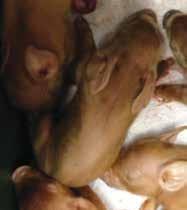
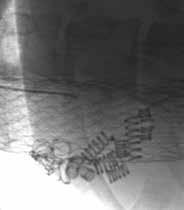

19 A CASE FOR PET INSURANCE
DEPARTMENTS
3 DEAN’S MESSAGE
15 SERVICE SPOTLIGHT
21 RESEARCH BRIEFS
22 CAMPAIGN UPDATE
25 FACULTY, STAFF & STUDENT NEWS
30 PENN ANNUAL CONFERENCE
31 DEAN’S ALUMNI COUNCIL UPDATE
32 ALUMNI AWARDS
34 ALUMNI NEWS
40 CALENDAR
Dr. Colin Harvey, professor of surgery and dentistry, performs a feline teeth cleaning. In his 47 years at Penn Vet, Dr. Harvey has played a major role in helping the school reach a level of excellence in dentistry and oral surgery unmatched by its peers.
NUMBER79 4 9 12
SUMMER 2013
By the time you read this issue of Bellwether, 113 students from the School of Veterinary Medicine will have proudly accepted their diplomas as members of the Class of 2013. Amidst the pomp and circumstance, this annual procession always reminds me of the many ways that Penn Vet shapes the future of our profession. As our graduates become clinicians, researchers, industry leaders, and more, they represent the highest level of educational training, showcasing to the world how veterinarians uniquely understand medicine in a way that all species benefit.
In an op-ed for the Huffington Post this spring, I shared how veterinarians approach medicine with a global perspective, supporting public health, playing a critical role in food safety and production, and providing integral research to help prevent and control diseases.
As you know, veterinarians receive training as rigorous as doctors of human medicine, as necessary for the only clinical profession that treats many different species.
We have a unique perspective for helping both the animal and human population by providing findings around diseases that animals and humans share – both infectious and non-infectious – and by ensuring our food supply is both safe and plentiful.
Or, as I like to say, veterinary medicine is the profession that stands between all of humanity and plague and famine.
Throughout Penn Vet’s rich history, we have led the way in advancing veterinary medicine, all the while changing how our profession is viewed.
And yet, given all that, the veterinary profession is still largely misunderstood. While veterinarians will always be needed to treat our companion animals, it is our ability to link animal science to human well-being, to advance food production and safety, and to provide critical defense from global pandemics that mandates continued support of the highest level of veterinary education.
One of the best ways to illustrate the continually growing role of veterinarians, I believe, is to highlight
Penn Vet’s ongoing dedication to progress and innovation. And it all boils down to three simple words:
PENN VET LEADS.
Throughout Penn Vet’s rich history, we have led the way in advancing veterinary medicine, all the while changing how our profession is viewed.
In this issue, you will read some incredible examples of how Penn Vet leads in three distinct categories:
• Collaboration
• History of firsts
• Global impact
Our expert clinicians and researchers collaborate with the best minds across the University and around the world to advance medical and scientific research. On page 15, you’ll read how we are breaking new ground in equine sports medicine through a variety of national and international collaborations. And on page 21, we focus on Dr. Charles Vite and his collaborative efforts with scientists from medical schools across the country to treat NiemannPick Type C disease in both animals and children.
Our history of firsts translates to unparalleled expertise. As you know, Penn Vet is the birthplace of many veterinary specialties such as cardiology, dermatology, and neurology. Our cover story perfectly illustrates this point by turning the spotlight on Dr. Colin Harvey, who is retiring from his position as professor of surgery and dentistry after a remarkable 47 years at the University. The first professor of veterinary dentistry in North America, Dr. Harvey pioneered many modern dentistry methods right here at Penn Vet.
Lastly, our research and training make a broad and deep global impact. One such example is our Swine Teaching and Research Center, which has influenced producers across the world. The article on page 9 highlights the Center’s ongoing interactions with Swiss Village Farm to create a diversified collection of rare breed animals available to both research scientists and the general public.
It is my hope that you will join me in sharing these stories – and many more – as key proof points of how Penn Vet Leads. We are equipped to be the best ambassadors for our field and for our School, and I look forward to seeing our efforts continue to make a lasting impact.
—JOAN C. HENDRICKS, V’79, GR’80 THE GILBERT S. KAHN DEAN OF VETERINARY MEDICINE

WWW.VET.UPENN.EDU/BELLWETHER 3 DEAN’S MESSAGE
HENDRICKS

4 BELLWETHER SUMMER 2013
pioneering a new field
BY KATHERINE UNGER BAILLIE
In 1965, during his final year in veterinary school at the United Kingdom’s Bristol University, Colin Harvey, BVSc, saw a notice posted on a bulletin board, advertising an internship in surgery at the University of Pennsylvania School of Veterinary Medicine. He decided to apply.

“I had no idea where Pennsylvania was,” says Dr. Harvey. “I just thought it would be an interesting way to spend a year.”
His stateside sojourn lasted longer than anticipated. In June, Dr. Harvey will retire after 47 years at Penn Vet, most recently as professor of surgery and dentistry in the Department of Clinical Studies-Philadelphia. His tenure has been marked by individual and institutional leadership in the development of a new field: veterinary dentistry.
Thanks to groundbreaking clinical and research discoveries, the development of training programs for veterinary students up through residents, and collaborations with experts inside and outside the veterinary world, Penn Vet has reached a level of excellence in dentistry and oral surgery untouched by its peers. The expertise in the School’s Dentistry and Oral Surgery Service has translated into unsurpassed care for patients, connections that inform animal as well as human medicine, and further innovation that promises to grow and elevate veterinary dental medicine into the future.
“The vast majority of people who are our peers consider us the best in the world in veterinary dentistry,” says Alexander Reiter, Dr. med. vet., chief of Penn Vet’s Dentistry and Oral Surgery Service and an associate professor of dentistry and oral surgery. “We really are at the top of our field.”
Dr. Harvey has played a major role in helping the school reach this level of achievement. In 1966 when he arrived at Penn for his internship year, however, veterinary dentistry did not exist as a distinct specialty.
“What became clear as I was going through my internship and stayed to do what became a residency,” says Harvey, “was that no one else was interested in dentistry. It fell to me as the lowest person on the totem pole to pursue it, but I enjoyed it.”
WWW.VET.UPENN.EDU/BELLWETHER 5
DENTISTRY
Dr. Harvey completed his residency in surgery in 1969 and joined the faculty as assistant professor of surgery in soft tissue surgery. As his surgery colleagues Robert Brodey, DVM, and Paul Berg, DVM, had primary interests in oncology and abdominal surgery, respectively, Dr. Harvey saw an opportunity to carve out his own area of expertise. He took “what was left,” as he puts it, which included either end of the patients requiring treatment: the rear end or the head and neck.
Making Connections
Though he was delving deeper into these specialties than his peers, Dr. Harvey did not do so alone. Collaborations with Dr. Berg and Joan O’Brien, VMD, a professor of animal medicine at Penn Vet, as well as others led to extensive advances and publications on ear, nose, throat, and anal and perineal conditions. But Harvey soon began to further specialize, narrowing to work primarily on the mouth. He quickly discovered that he and his colleagues were lacking basic information about how to treat problems of the teeth and gums in companion animals.
Luckily, help was just down the street, at the School of Dental Medicine.
Harvey reached out to his colleagues in the dental school, who would occasionally come to Penn Vet to look at cases and share tips about basic dentistry techniques. But their consults could only take the vet faculty so far.
“Dogs with raw mouths needed treatments, and often treatment consisted of extraction of teeth,” Dr. Harvey says. “At that time, extractions were done without appropriate equipment, because we did not know any better. The roots were left in and mouths ended up looking like warzones at the end of the procedures. There clearly was a need for improvement.”
Fortunately, the dental school was soon poised to offer more than intermittent advice. Penn Dental Medicine had been home to a program to train dental hygienists, which was slated to close as the University eliminated non-degree programs in the late 1960s and early 1970s. Because the cuts would leave tenured faculty in dental hygiene without a role to play, the dental school’s dean at the time, Walter Cohen, saw an opportunity for them to contribute at Penn Vet. Soon, registered dental hygienist Roberta Throne began working at Penn Vet, instructing vets on the best way to ensure animals’ teeth were cleaned properly.
“The result of having her here was an immeasurable improvement in the standard of care we were able to provide for dogs that had severe periodontal disease that was not severe enough to require extractions,” says Dr. Harvey. “By the time Roberta retired, it was clear that a registered (human) dental hygienist was an essential part of the Penn Dental Service team.”
That team now has two registered dental hygienists on staff. Dr. Harvey says their presence “ensures not only excellent patient care, but also excellence in conducting research that requires meticulously detailed scoring of teeth.”
OPERATORY
Plans are now in the works to further advance Penn Vet’s Dentistry and Oral Surgery Service with the renovation of the dental and oral surgical operatory. Upgrades to the digital radiography system, anesthesia equipment, storage space, and a treatment table are all part of the plans for the new facility. Negotiations are underway for donation of equipment. Donations to cover the other costs of the renovations are being accepted in Colin Harvey’s honor. The remodeled facility will bear the name “Colin Harvey Dentistry and Oral Surgery Operatory.” If you are interested in making a gift in honor of Dr. Harvey and the Penn Vet Dental and Oral Surgery Service, please contact Helen Radenkovic, Director of Development for the Ryan Hospital, at 215-898-2029 or hrad@vet.upenn.edu.
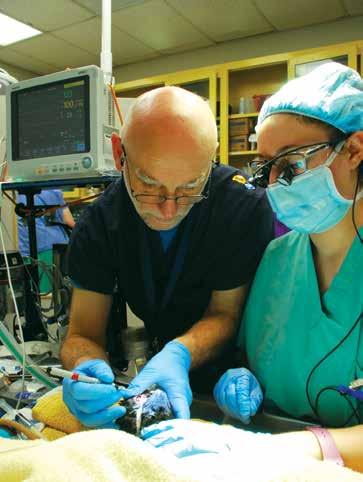
6 BELLWETHER SUMMER 2013
Formalizing a Discipline
Expertise in veterinary dentistry was growing at Penn Vet through the 1970s into the early 1980s, when the Penn Vet Dentistry and Oral Surgery Service was created out of the Soft Tissue Surgery Service, making it the first stand-alone dental service at a North American veterinary school. The Service offered endodontic, periodontal and restorative work as well as oral and maxillofacial surgery.
Meanwhile, Dr. Harvey took steps to augment the field on a larger scale, well beyond Penn’s campus. In 1976, he was one of the founding members of the American Veterinary Dental Society, along with several private practitioners. This group lobbied for the recognition of a dental specialty in the American Board of Veterinary Specialties, achieving that aim in 1988 with the formation of the American Veterinary Dental College. Dr. Harvey also worked to grow the field in Europe and elsewhere, playing roles in the establishment of the European Veterinary Dental Society and the European Veterinary Dental College.
In addition to creating new institutions, Dr. Harvey also contributed a wealth of scientific and clinical publications, including approximately 70 chapters in textbooks, 130 papers in peer-reviewed journals, 100 abstracts and other papers on surgical or dental topics, and five books written, edited or co-edited on small animal surgery and dentistry.
His 1993 book Small Animal Dentistry, co-authored with Peter Emily, DDS—a human dentist who took an interest in veterinary dentistry and became a long-time collaborator of Dr. Harvey’s— stands as a reference even today.
“Any time someone asks me what book I recommend in veterinary dentistry,” says Dr. Reiter, “I pick up Harvey and Emily’s book. It may be 20 years old, but the information that is in there about the pathologies that can be seen inside and
around the mouth hold as some of the best described of any text in the field.”
Training Tomorrow’s Practitioners
To keep pace with the advancement of the discipline, Dr. Harvey and his colleagues at Penn Vet have expanded offerings in dentistry to veterinary students.

“There are techniques in dentistry that, for many years, we as veterinarians were expected to know how to do without ever having been taught how to do them,” says John Lewis, VMD, an assistant professor of dentistry and oral surgery. “Now, an increasing number of vets will have the knowledge and experience to appropriately care for and advise their clients on their patients’ dental needs.”
In the early 1980s, Penn Vet students were offered an elective program in dentistry, a world first. Penn Vet was also the first veterinary school to offer a clinical rotation in veterinary dentistry and oral surgery for fourth-year students, during which students learn how to do a thorough oral examination, take dental radiographs, professionally clean teeth, and perform extractions. Third-year students can take an elective lecture course, developed by Dr. Harvey, in which they learn everything from how to perform a professional dental cleaning to how to assess oral cancers. Students also engage in learning outside the classroom; each year, 30 to 50 students are enrolled in the student chapter of the American Veterinary Dental Society, attending lectures and participating in extracurricular workshops.
Starting in 1990, graduates with a desire to specialize in dentistry were able to continue learning in Penn’s Veterinary Dentistry and Oral Surgery Residency Program—the first such program of its kind. Since its creation, 19 professionals have been trained and have become board-certified veterinary dentists, hailing from the U.S. as well as countries including Australia, Austria, Brazil, Finland, France, Germany, Italy, Japan and the United Kingdom. Dr. Harvey put a priority on training individuals from outside as well as inside the United States, hoping to spread the influence and weight of Penn’s expertise in dental research and practice globally.
Among those who have gone through the program are Dr. Harvey’s colleagues in the Penn Vet Dentistry and Oral Surgery Service, Drs. Reiter and Lewis. Dr. Reiter was persuaded to enter the program after giving a lecture on tooth resorption in cats at a conference in Denver in 1997. Following his talk, a man came up to him and asked to discuss his research over coffee.
When the man introduced himself as Dr. Harvey, “I was speechless,” Reiter says. “Dr. Harvey has an excellent reputation; he’s been everywhere in the world, at all kinds of courses and conferences, so he’s a world player.”
Just a few months later, Dr. Reiter was on his way to Penn.
Oral Health
WWW.VET.UPENN.EDU/BELLWETHER 7
DENTISTRY
Dr. Michael Jennings (left) and Dr. Colin Harvey attend to their patient as a student looks on.
Over the last couple of decades, Dr. Harvey has turned his focus largely on the question of how oral hygiene, oral health and general health are linked.
In human medicine, researchers and clinicians have for years identified clues suggesting that a relationship existed between periodontal disease and poor health, including increased rates of cardiovascular disease, diabetes and preterm birth. Dr. Harvey took up this line of investigation in animals, working for years to confirm a cause-and-effect relationship between the two. He’s overcome obstacles in experimental design, as well as challenges inherent to working with canine and feline teeth—the size, shape and function of which are highly variable as compared to human teeth.
Only recently has he felt comfortable enough to accept he’s found the first signs in dogs that the correlation may indeed be causation. In a paper in the 2011 Journal of American Veterinary Medical Association, Harvey, Penn Vet colleagues Jennifer Rawlinson and Alex Reiter, and others, reported on a study of dogs with gum disease.
“Our study shows that if you scale the teeth of dogs with periodontal disease and measure C-reactive protein, which is a protein produced when the body is stressed by disease or trauma, we’ve found that it goes down,” says Harvey. “It’s the first rigorous study to suggest that the cause-and-effect relationship is real.”
Confident that more extensive studies will continue to confirm these findings, Dr. Harvey has worked to broaden awareness in the general public of the importance of oral hygiene for companion animals. His efforts have led to the creation of the Veterinary Oral Health Council, an organization which recognizes commercial products that meet standards for effective oral care in dogs and cats, akin to the American Dental Association’s “Seal of Acceptance” on tooth-care products for humans.
“The more convenient we make it for pet owners to provide oral care for their animals on a daily basis, the more effective that care will be,” Dr. Harvey says.
Blazing New Trails
Looking to the future, Drs. Harvey, Reiter and Lewis see a world of possibilities for the veterinary dental profession, and for Penn Vet’s role in it.
Together, Drs. Reiter and Lewis have been identifying new surgical techniques to tackle some of the most complex oral and maxillofacial injuries, spanning the range from maxillofacial reconstruction following gunshot wounds to repair of jaw defects from oral cancers. The implications for the advancement of both veterinary and human surgery are enormous.
“Dr. Reiter and I have continued to take advantage of the geographic proximity of Penn’s other health schools, including the medical school, the dental school and the nursing school,” says Dr. Lewis.
Drs. Reiter and Lewis have, for example, worked with Penn
RECEPTION TO HONOR DR. HARVEY
Colin Harvey will be honored at a retirement reception on June 17, to which residents, interns, students and staff—past and present—are warmly invited. The event will also feature a continuing education program in veterinary dentistry and oral surgery. For more information, please contact Cheryl Arthur at carthur@vet.upenn.edu.
colleagues to develop a Comparative Oncology working group, in which they discuss cases of oral cancers and reconstructive efforts in humans and companion animals. Ongoing studies involve options for maxillofacial reconstruction in dogs. These discussions have led to concrete benefits for patients and new approaches to veterinary cases. In one case, clinicians at Penn Vet treated a dog with a gunshot wound to its face that had suffered a five-centimeter defect of its lower jaw. With input from Ara Chalian, MD, of Penn Medicine, Drs. Reiter and Lewis used a recombinant bone morphogenetic protein during surgery on the dog. That was in 2006; today, the dog is still doing well with its reconstructed jaw.
In addition, earlier this spring, Reiter began making connections in the hopes of furthering cross-university partnerships. In a talk at Penn Medicine, he presented on the comparative use of microsurgery between humans and companion animals.
“I proposed my idea of bringing together the schools of Medicine, Dental Medicine, and Veterinary Medicine to eventually create an interdisciplinary, comparative microsurgery teaching and research center,” Reiter says.
Another line of investigation by Dr. Lewis—research on treatments that may extend the life of cats with squamous cell carcinoma—may also have implications for humans.
“This has the potential to be a promising translational model,” Dr. Lewis says. “Squamous cell carcinomas are the number one oral tumor of both cats and humans.”
For his part, Harvey will remain active professionally with the American Veterinary Dental College and the Veterinary Oral Health Council. He sees potential for growth in zoo and exotic animal dentistry, as well as in equine dentistry, as animals live longer in captivity or as pets.
Dr. Harvey hopes his inroads in veterinary dentistry are only the beginning.
“There are so many areas of the field that require study because it’s a young specialty,” says Dr. Harvey. “There is still a lot to be done.”
8 BELLWETHER SUMMER 2013
Swine Teaching and Research Center Partners with Swiss Village Farm

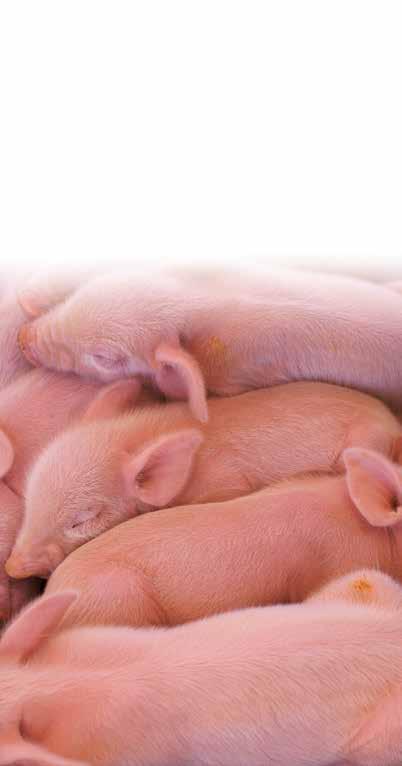 BY JANE SIMONE
BY JANE SIMONE
The world’s population, currently a staggering 7.1 billion, is estimated to reach 10.5 billion by 2050. Why should we care? Hasn’t the world’s population been steadily increasing since the Great Famine and the decimations of the Black Death in the 14th Century? Indeed it has, and since the end of World War II, that growth rate has been phenomenal. Elsewhere in the world, populations continue to grow, and burgeoning middle classes in countries like China and India, as well as the African continent, are using their new found wealth to change their dietary habits, consuming more animal protein than ever. Thus, concerns voiced by experts such as the United Nation’s Food and Agriculture Organization that the world may not be able to meet its demands for meat, milk and eggs in coming years are well founded.
WWW.VET.UPENN.EDU/BELLWETHER 9
What does that have to do with veterinary medicine?
A lot, actually. It is all about supply and demand. The veterinary profession is critical to animal agriculture. Modern western production methods have led to a significant diminution in the variety of animal breeds being raised for consumption. According to the National Pork Board, in the US alone, there are only eight major swine breeds in the pork production pipeline. Pork accounts for 40 percent of the protein consumed worldwide, so veterinary oversight of pork production is crucial to ensure a safe, high-quality meat, especially since pigs are raised in high volume (between 100 and 120 million each year in the US alone) and in close quarters on most large scale farms.
This reduction in the variety of breeds being raised is problematic, as it reduces genetic variability and our herds’ ability to adapt to change and makes the food supply vulnerable to catastrophic pandemics. Part of the research being done at Penn Vet’s Swine Teaching and Research Center addresses what behavioral traits may be advantageous for the future and which breeds are the repository of these critical traits.

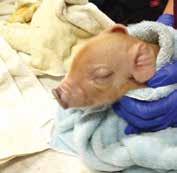
This is where a very special and unique collaboration comes into play. Since 2010, Penn Vet has been working with the SVF Foundation at Swiss Village Farm in Rhode Island. The Foundation was established in 2000 by Mrs. Dorrance Hamilton, and its mission is “to preserve genetic material from rare and endangered breeds that could be used to respond to any future catastrophic loss of animal populations and also restore the loss of variety in species that contribute to current food animal vulnerabilities.” Until the Foundation’s involvement with Penn Vet, its principal focus had been on cattle, goats and sheep.
Mrs. Hamilton’s vision to preserve rare breeds is compelling and shows her keen understanding of the dangers of lack of diversity in the food animal population. For example, according to the Holstein Association USA,

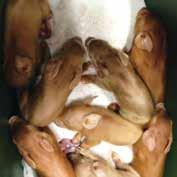
the Holstein accounts for almost all dairy cows in the US as nine out of ten dairy farmers milk Holsteins. The breed is renowned for its superior milk production, genetic merit and adaptability to a wide range of environmental conditions. But what if a catastrophic new disease decimated the Holstein population? As the dominant dairy breed in this country, the effect would be devastating both for the dairy industry and the consumer. The same is true for swine, given the relatively limited genetic pool with which pig farmers currently work.
The collaboration between the SVF Foundation and Penn Vet’s Swine Teaching and Research Center is therefore tremendously important to both organizations’ work. Dubbed “on-hoof conservation,” Sarah Bowley of SVF has been locating rare or heritage breed swine for study by Dr. Tom Parsons and his colleagues at the Swine Center’s Behavioral Unit. Pregnant mother sows are transported from breeders across the country to the Widener Large Animal Clinic at Penn Vet’s New Bolton Center. To prevent the introduction of unwanted diseases to New Bolton’s swine herd, an elective Caesarian section is performed by the department of surgery to aseptically remove the piglets from their mothers. The piglets are then transferred to the Swine Center and adopted by awaiting surrogate mothers from the existing herd. These animals will be raised and bred in the Swine Center to build a bio-secure founder population of rare breed animals.
For nearly 40 years, commercial sows have been selected to perform in the predominant type of sow housing called the gestation stall. Growing consumer concern about the stall has resulted in over 50 nationally branded food companies promising to remove gestation stalls from their supply chains during the next decade (see side bar). The heritage breed animals have not been subjected to the same intensive selection pressure as their commercial counterparts,
10 BELLWETHER SUMMER 2013
Newborn Tamworth piglets drying.
Rare breed Tamworth piglets interact with their foster siblings.
The following companies have committed to eliminating gestation stalls from their supply over the next decade. Several of these companies have visited the Swine Teaching and Research Center to learn more about the challenges and solutions that their suppliers will face during this transition.
Applebee’s and IHOP (owned by DineEquity)
ARAMARK
Arby’s Atlantic Premium Brands
Au Bon Pain
Bob Evans
Bon Appétit Management Company
Bruegger’s Bagels
Burger King
Campbell Soup Co.
Carnival Cruise Lines
CKE Restaurants, owner of the Carl’s Jr. and Hardee’s chains
Compass Group
ConAgra Foods
Co-op Atlantic
Costco
Costco Canada
Cracker Barrel
Denny’s
Dunkin’ Brands
Einstein Noah Restaurant Group, owner of Einstein Bros. Bagels, Noah’s New York Bagels, and Manhattan Bagels
Federated Co-operatives
Fresh Enterprises
General Mills
Harris Teeter Supermarkets
Hormel Foods, maker of SPAM
Kraft Foods
Kroger
Loblaw
Maple Leaf Foods
Marriott International
McDonald’s
Metro
Metz Culinary Management
Royal Caribbean
Safeway
Safeway Canada
Smithfield Foods
Sobeys
Sodexo
Sonic SUBWAY
Supervalu
Sysco
Target
The Cheesecake Factory
Tim Hortons
Walmart Canada
Wendy’s
Wienerschnitzel
Williams Sausage Company
to be archived with the other genetic material SVF has been preserving. New Bolton Center also plans to become a source of rare breed animals for pig breeders and restaurateurs alike. Finally, the New Bolton Center work will help existing heritage breeders increase genetic diversity in their current herds through reproductive technologies associated with semen collection, handling and artificial insemination – all the expertise of Dr. Gary Althouse, Chair of New Bolton Center’s Clinical Studies and an expert in this field.
and thus, the Swine Unit’s immediate goal is to see if heritage breed animals can provide behavioral traits lost from commercial animals that might be helpful in the stall-free housing systems of the future. If so, then the heritage breeds could become more mainstream and no longer be at risk of progressing from rare to endangered.
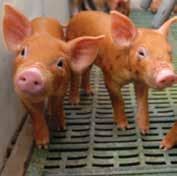
The longer-term goals for heritage breed animals would be to collect semen, embryos, and stem cell progenitors

Penn Vet and its extraordinarily gifted researchers are constantly working to answer questions that are crucial to everyone’s future. One of the most critical outcomes of this collaboration is the opportunity to work on joint education efforts to share information on the importance of biodiversity relative to food security.
Dr. Parsons’ partnership with the SVF Foundation to proactively work towards preserving rare breeds and to identify traits that might make them relevant to farms of the future is just one significant example of the School’s leadership role in areas that affect each and every one of us.
WWW.VET.UPENN.EDU/BELLWETHER 11
Hillshire Brands, a major meat company operating the Jimmy Dean, Ballpark, and Hillshire Farm brands
Piglets nurse from their foster mother.
“The Best Place on Earth”
BY HELEN RADENKOVIC


Mina Ebrahimi hastens into Penn Vet’s Ryan Hospital lobby anxious and overwhelmed with concern for her beloved nine-and-half-year-old chocolate lab, Jack. She left her home in the Washington, DC metro area at 3:30 a.m. to drive to Ryan Hospital because Jack’s coughing and respiratory fits were worsening. Jack is by her side, happily greeting the Hospital security guard, Lona, with kisses. Lona opens her arms to embrace Mina and welcome her – they are old friends, and Mina has made this long drive many times before. As far as she is concerned, Penn Vet is the only suitable place to bring Jack at a time like this. With unmatched expertise, innovative tools and great compassion, Penn Vet’s Ryan Hospital addresses the most complex companion animal diseases.

Mina and Jack have been coming to Ryan Hospital since 2004, after Jack was diagnosed with an intrahepatic liver shunt, a life-threatening genetic development where a blood vessel carries blood around the liver instead of through it, compromising the organ function. Jack was just a puppy when he was diagnosed by his primary veterinarian in Virginia, and one of the very first dogs to benefit from a complex Interventional Radiology procedure previously only available to humans. During the

12 BELLWETHER SUMMER 2013
Mina and Jack
novel, minimally invasive procedure, metal coils were inserted into Jack’s shunt to promote coagulation and close off the abnormal blood vessel in his liver. The procedure was a success. However, the young puppy’s ordeal was not yet over.

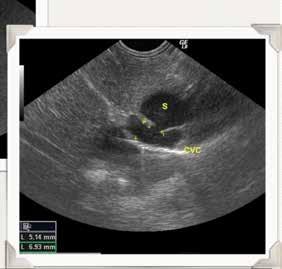
Shortly after healing from his procedure, Jack had to be rushed back to Penn Vet to address a gastric ulcer and severe gastrointestinal bleeding, which is a complication that can occur in dogs with intrahepatic shunts.
With intense medical treatment, Jack made it through these close calls. Inspired by the level of care and compassion she and Jack experienced, Mina expressed her gratitude through an incredibly generous gift, naming the Jack Miller-Ebrahimi Interventional Radiology Program at Penn Vet.
Eight years after Jack’s first visit to Ryan, he and Mina are back to address his breathing problems. It is another emotional, nerve-wracking day for Mina, but as soon as she sees her team of clinicians, Dr. Susan Volk, assistant professor of small animal surgery, and Dr. Mark Rondeau, an internal medicine specialist, she is visibly relieved and breaks into a big smile. Warmth and affability come easily to Mina and she instantly makes two new friends at Penn Vet. She breathes a sigh of relief knowing that Jack’s breathing issues will be examined and addressed from every possible angle by some of the finest clinicians in the field.
Jack’s coughing condition is currently being managed with medication and continued observation. While dogs with liver shunts never grow to full size, at 90 pounds, Jack is full of Labrador energy! Little slows him down. The only reminder of his liver shunt hardship is his silky soft puppy coat that never quite developed into an adult coat – just one more way that Jack is special.
Mina expressed her gratitude to Penn Vet for the expert care provided to Jack with yet another extraordinary gesture of generosity. With an additional gift, she purchased much needed anesthesia and Interventional Radiology equipment; supported exciting research in novel stem cell therapies; sponsored the training, health care and food for a puppy in
training to become a detection dog at the Penn Vet Working Dog Center; and purchased training supplies and provided marketing funds for the Center.
“Penn Vet is the best place on earth,” Mina declares. “And it’s not only because Jack’s treatment was successful, but also because of the brilliant people here and the School’s history of clinical innovation.”
Whenever Mina visits Ryan Hospital, she makes a genuine effort to connect with each clinician who treats her beloved dogs. She also takes the time to learn about new, exciting advancements in veterinary care and the programs being pioneered at Penn Vet. This is how she learned about the novel stem cell therapy research and the Penn Vet Working Dog Center, which she decided to support.
Mina also has taken on the responsibility of promoting the high-quality care, research and teaching at Penn Vet through social media efforts and press releases and by hosting events. Recognizing this passion, Dr. Joan Hendricks, Gilbert S. Kahn Dean of Veterinary Medicine, welcomed Mina to the School’s Marketing and Development Committee, where her enthusiasm and acute business acumen make a meaningful impact. Mina also got her sister, Sarah Miller, involved with supporting the Working Dog Center and exciting marketing initiatives for the School.
When she is not advancing Penn Vet’s mission, Mina owns and runs Saint Germain Catering, the largest corporate catering business in the Washington, DC metro area. In 2010, she won the CEO Brava Award for Women Leaders, and in 2011, she was named one of the Top CEO Leaders under 40 years of age in the Washington, DC metro area. In April of 2013, she started the Mina Ebrahimi Foundation to support a variety of charities and women’s causes. She continues her involvement with the Ronald McDonald House and Operation Homefront, an organization which provides emergency financial and other assistance to the families of service members and wounded soldiers. Between spending time with her family and friends and growing her business and her philanthropy, Mina never loses momentum.
Today, Mina is focused on advancing the Jack MillerEbrahimi Interventional Radiology Program at Penn Vet. With Dr. Dana Clarke, a lecturer in Interventional Radiology

WWW.VET.UPENN.EDU/BELLWETHER 13
Computed tomography angiogram showing stent and caudal vena cava (light area, left of center).
Ultrasonographic image showing shunt (S) and caudal vena cava (CVC).
and Critical Care, at the helm of the Interventional Radiology program, Ryan Hospital provides minimally invasive treatment with less chance of infection, less pain and a decreased recovery time for animals suffering from a number of diseases. Interventional Radiology utilizes fluoroscopy, a real-time moving x-ray imaging modality, to visualize the placement of catheters, stents, balloons and coils into blood vessels, the urinary system, the respiratory system and other tubular structures.
Among Mina’s generous gifts of equipment are a portable fluoroscopy unit, also known as a portable C-Arm, and a laser lithotripsy machine. The first in a veterinary teaching hospital in the nation, this C-Arm enhances the way Penn Vet clinicians perform a variety of surgical procedures such as cardiology, orthopedics, and urology. The laser lithotripsy machine enables Dr. Clarke to treat painful bladder stones by delivering laser pulses through a fiber optic scope inserted into the urethra to pulverize the stones in the bladder. The stones are then able to be removed with a basket and without the need for a single incision. Both tools have transformed the way Dr. Clarke and her colleagues deliver care to beloved pets and they have helped to establish Penn Vet as a leader in minimally invasive surgery.
Dr. Clarke is passionate about using her critical care background to further this emerging field. She is a firm believer in collaboration and exchange of knowledge, and has been joined by top Interventional Radiology specialists from the University of Pennsylvania’s Perelman School of Medicine to perform procedures at Ryan Hospital. Mina could not be more proud to see that the Jack MillerEbrahimi Interventional Radiology Program has taken such an enlightened path in developing new knowledge. Her vision is that, in addition to delivering unparalleled care, Penn Vet will become the top veterinary teaching and training venue in Interventional Radiology.
Most recently, Mina returned to Ryan Hospital with her other chocolate lab, Tony, to address his walking difficulties. She was upset, crying intermittently as she described Tony’s symptoms to Dr. Adam Moeser, a neurology specialist. Tony’s symptoms were suggestive of a number of maladies that ranged from neurological to orthopedic. Mina was desperate to find an answer to alleviate Tony’s recurring problems. Dr. Moeser and Dr. Kim Agnello, an assistant professor of surgery who specializes in minimally invasive orthopedic surgery, took an in-depth look into what was limiting Tony’s mobility and causing him discomfort. Comprehensive neurological and orthopedic examinations, x-rays, magnetic resonance imaging (MRI), and the GAITfour electronic walkway system ruled out a spinal cord abnormality and suggested that osteoarthritis was the source of Tony’s recurring pain. A new diagnostic modality in Dr. Agnello’s tool box, the GAITfour is an innovative technology used to evaluate the gait of animals with
possible arthritis and other orthopedic diseases.

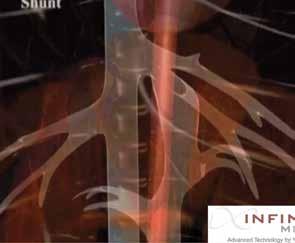

Since his diagnosis and prescribed medications, Tony is feeling much better. “He is like a new puppy again,” Mina exclaims.
Back at home, Mina has two more Labradors – a yellow lab named Barney and a black lab named Suzie. Along with Jack and Tony, their wellbeing is one of Mina’s greatest priorities. She believes that providing the finest veterinary care is the least she can do for her Labradors in exchange for the support and healing they provided to her after an accident left her wheelchair-bound and in rehab for almost two years. Both of Mina’s ankles were shattered in a jet skiing accident during a family vacation, and she endured difficult surgeries and a challenging rehabilitation. With the support of her family –both human and canine – Mina made a remarkable recovery. It was during those trying, dismal days filled with pain that her canine companions provided the kind of quiet, loving support that allowed Mina to remain hopeful about her recovery and future quality of life.
“They saved me, and I’ll do anything for my babies. My dogs and Penn Vet helped me to build myself as a person.” Mina’s devotion to her pets is undeniable, and her choice for their care is Penn Vet’s Ryan Hospital. Her experiences here showcase some of the many ways that Penn Vet leads the veterinary profession.
14 BELLWETHER SUMMER 2013
Animation of stent being inserted. (Infiniti Medical).
Finished procedure showing stent with coils.
Sports Medicine – Leading the Way
BY JANE SIMONE
WHY EQUINE SPORTS MEDICINE?
In a nation obsessed with sports from Pop Warner football and Little League to the NCAA and Major League Baseball, it’s little wonder that Sports Medicine for humans is a thriving, ever-expanding specialty. What’s less well-known is that, with the possible exception of dogs in activities as diverse as field sports, agility and dog-sledding, the horse is probably the most elite athlete, competing at the highest numbers of any animal in the world. Horses are flown, trucked, trailered and rail-roaded to competitions all over the US and the world in numbers second only to human travel.
The American Horse Council, in its most recent Economic Impact Study of the horse industry, reported that the combination of racing, showing (all disciplines –hunters, jumpers, eventers, dressage, reining, barrel racing, roping, etc.), recreation and “other” totaled 9.2 million horses. Humans associated with this astonishing number totaled 4.6 million, accounting for owners, trainers, farm employees and volunteers. What did this mean for the nation’s gross domestic product? Nothing less than $101.5 million.
It’s not surprising, then, that Penn Vet’s New Bolton Center responded to the tremendous growth in horse sports in the latter decades of the 20th century by pioneering veterinary medicine’s equine sports medicine specialty. Long known for its work with Thoroughbred

racehorses, New Bolton Center also serves a significant sport horse population that calls south-east Chester County home. But its Sports Medicine clinicians also see horses from much farther afield, and its board-certified clinicians willingly travel to farms all over the country and abroad to consult, diagnose and advise clients in the best interests of their athlete horses. In addition, with the technological advances in viewing imaging studies, consultations can be performed on images obtained by veterinary colleagues examining horses at off-site locations.
SPORTS MEDICINE RESOURCES AND EXPERTISE
So what should a client expect to find when he or she brings an animal to New Bolton Center’s Sports Medicine Section for evaluation? What does this Section provide that is special and possibly not available elsewhere?
The Sports Medicine Section at New Bolton Center comprises a team of board-certified, internationally recognized clinicians with extensive experience in the areas of poor performance evaluations, complex lameness evaluations and cutting-edge treatment options, prepurchase examinations, general and sports cardiology, diagnostic ultrasound, MRI, CT and nuclear medicine imaging. Knowledgeable, professional sports medicine
WWW.VET.UPENN.EDU/BELLWETHER 15 SERVICE SPOTLIGHT
Dr. Ben Martin conducts a treadmill run to test for possible respiratory disorders.
technicians assist in providing exceptional patient care and in optimizing the client experience. This team is committed to keeping equine athletes healthy and “in the game” as well as assisting owners, trainers and riders to meet their athletic goals.
The Section is led by Dr. Virginia Reef, a worldrenowned leader in the field of equine cardiology. Dr. Reef’s many national and international collaborations speak to her advanced expertise. She is board certified by the American College of Veterinary Internal Medicine and the new American College of Veterinary Sports Medicine and Rehabilitation, and is an associate member of the European College of Veterinary Diagnostic Imaging. Other members of the Sports Medicine and Imaging team include Dr. JoAnn Slack, board certified by the American College of Veterinary Internal Medicine, and Drs. Elizabeth Davidson, Benson Martin and Michael Ross, all board certified by the American College of Veterinary Surgeons. Each of these exceptional clinicians is a leader in different aspects of Sports Medicine and Imaging, enabling a comprehensive evaluation of all different types of sport horses and their problems to be performed by specialists in the field. These clinicians also are involved in training an elite group of interns, residents and fellows in these subspecialties.
As a result, an owner who brings his or her horse to New Bolton Center has a wealth of knowledge and experience to draw on from all of the clinicians and technicians who make up the Sports Medicine Section. This knowledge and experience comes from years of seeing one of the highest case loads in the country. It is also born of the collaboration with their New Bolton Center colleagues in Surgery, Medicine and Ophthalmology, Neurology, Radiology (including CT scans and MRI capability), Reproduction and Equine


Behavior, Critical Care and Emergency Medicine, Anesthesia and Farrier Services. There is no private practice that can offer such a wide range of specialties and services in one location or have them performed by individuals who are considered experts in each specialty and subspecialty.

FLEXIBILITY AND SCOPE
New Bolton Center is proud to offer the client what might best be described as “one-stop shopping” for a variety of sophisticated tests, as needed. All appointments can be made for the client before he or she arrives at New Bolton Center to ensure the most efficient use of his or her time. Stress on the patient is also reduced. Instead of making multiple trips to a variety of practices for different tests, all can be quickly and expertly handled at New Bolton Center in a day or two, depending on the initial findings. Follow-up visits may be needed and can be quickly arranged, again reducing stress on both patient and client. Clients receive detailed descriptions of their animals’ diagnosis, treatment and follow-up care, and clinicians are readily available to address any concerns or questions they may have.
In addition to this clinical expertise, the Sports Medicine services are housed in one of New Bolton Center’s more recently constructed buildings – The Scott Equine Sports Medicine facility, which was dedicated in 2002. This state-of-the-art facility consists of two diagnostic areas, one with two sets of stocks for diagnostic ultrasound and one with a single-stock space dedicated to cardiology, plus three holding stalls and a Cardiology/ Ultrasound Office where studies can be examined. The latest in high-tech ultrasound, echocardiography, EKG and radiotelemetry equipment is available, and
16 BELLWETHER SUMMER 2013 SERVICE SPOTLIGHT
Ultrasound being used in a variety of ways to detect possible health issues in horses.
the generous space, great footing and high ceilings make it a welcoming space for patients, owners, clinicians and students.
The Scott building is adjacent to the Jeffords High Speed Treadmill Facility, opened in 1992 as one of the first of its kind in the country. More than 3,000 patient evaluations have been carried out on the Jeffords Treadmill for poor performance issues such as lameness, upper and lower respiratory tract changes, cardiac disease and sub-clinical myopathy (“tying-up”). The tailor-made treadmill offers the ability to follow up a comprehensive lameness exam for a poorly performing horse with a brief schooling test, during which the patient may have arterial catheters placed in a facial artery and an endoscope passed into the pharynx. A typical test is run for 1600 meters at a speed designed to increase the horse’s heart rate to 200 beats per minute. The horse is then immediately taken off the treadmill and a postexercise echocardiogram is performed. An ECG is taken before, during and after exercise, and a post-exercise bronchoalveolar lavage (endoscopic washing with sterile fluid of the lungs, allowing clinicians to examine cell samples that aid in diagnosis) is performed. Subsequently, all of the data is taken from each test and a solution is proposed to the client to improve the performance of his or her horse.
TREATMENTS AND THERAPIES
Many other services are available to the client, as well, including diagnostic nerve blocks, wireless digital radiography, nuclear scintigraphy, joint injections, IRAP (interleukin-1 receptor antagonist protein), PRP (platelet-rich plasma), stem cell therapy, extracorporeal shock wave therapy, Lameness Locator®gait analysis equipment, therapeutic ultrasound and acupuncture.
Educating Future Sports Medicine Veterinarians
Not only do the remarkably gifted clinicians at New Bolton Center treat animals brought to them for everything from prepurchase evaluations to sophisticated diagnostics, treatment and care, but they also are responsible for teaching future veterinarians the latest advances in equine sports medicine. Penn Vet students have unique opportunities for equine sports medicine-focused training that is not available to students at other veterinary schools. A four-week course of concentrated training in diagnostic imaging, sports cardiology, lameness, advanced therapeutics and farriery is available to select students with an equine focus. This is an integrative program in equine sports medicine and imaging in which students develop the ability to synthesize information from the clinical examination, diagnostic imaging service and patient management, preparing them for clinical sport horse practice. Following graduation, these students are highly sought after for internships, residencies and private sport horse practice jobs because of their reputation for excellent knowledge and clinical skills.
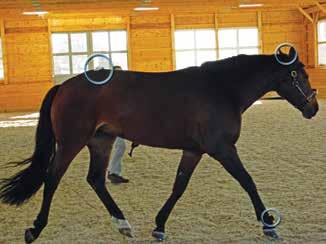
SERVICE SPOTLIGHT WWW.VET.UPENN.EDU/BELLWETHER 17
A patient is evaluated using computer sensors in the new Ilona English Equine Performance Evaluation Facility.
The most recent addition to Sports Medicine’s resources is the brand new Ilona English Equine Performance Evaluation Facility – a bright, airy indoor riding hall with one of the most advanced footings in the world. New Bolton Center is the first and only veterinary facility in the US to boast this footing, and it is deemed superior to all others for the clinical work being done by the Sports Medicine clinicians. The facility is perfect for lameness evaluations of horses that are ridden, as well as other exercising examinations.
THE IMPORTANCE OF RESEARCH
Advances in the clinical practice of equine sports medicine cannot be made without research that expands our understanding of various disease processes and potential therapeutic options. New Bolton Center’s Sports Medicine Section is internationally recognized as a leader in studying horses with poor performance, with a particular focus on upper and lower airway diseases in racehorses and cardiac causes of poor athletic performance. International collaboration is underway with the Universities of Zurich and Ghent, looking at atrial stunning (when the electrical function of the heart has been restored, but the contractile function has not yet returned to normal) following conversion of horses with atrial fibrillation to normal sinus rhythm. Another collaboration is proceeding with Washington State University and the University of Barcelona, looking for coagulation abnormalities in horses with atrial fibrillation (common in people with atrial fibrillation). Atrial fibrillation is one of the more common heart abnormalities in horses, and its implications can be very serious for both horse and rider. Ongoing collaborative work with the University of Veterinary Science in Norway is focused on evaluation of exercising heart rhythms in the Norwegian Coldblooded Trotter. In addition, New Bolton Center’s work performed in association with the Pennsylvania Harness Horsemen’s Association at Pocono Downs and Chester Downs and the Meadows Standardbred Owners Association has looked at cardiac arrhythmias and heart muscle injury in apparently healthy racing Standardbreds.

Research within the Sports Medicine Section is not confined to poor performance in the sport horse. Independent and collaborative research efforts have produced new information in the areas of neonatal ultrasound, ultrasound evaluation of the high risk mare, cardiovascular changes during experimental endotoxemia, effects of dehydration on cardiac ultrasound, the accessory sex glands of geldings, ultrasound of the lower urinary tract and cardiac arrhythmias in patients with severe hemorrhage. A large prospective study evaluating the accuracy of abdominal ultrasound in cases of acute colic is
also currently underway.
LEADING THE PROFESSION
If further proof is needed of why an owner would want to bring an animal to New Bolton Center for evaluation and work-up, it is important to highlight that New Bolton Center is one of the leaders in providing national continuing education to practicing veterinarians in the areas of equine cardiology and diagnostic ultrasound. New Bolton Center clinicians have delivered presentations at the annual meetings of the American Association of Equine Practitioners and the American College of Veterinary Internal Medicine, and have participated in professional meetings in Europe, Scandinavia and South America. Dr. Reef’s textbook Equine Diagnostic Ultrasound, and Drs. Ross and Dyson’s textbook Lameness in the Horse are the primary reference books in their field. It is also true that New Bolton Center has trained most of the leaders in equine ultrasound and cardiology in North America.
New Bolton Center’s Sports Medicine Section is undoubtedly a leader in its field. The Section’s scope of expertise, services and resources is truly incomparable. Penn Vet can be justly proud of its work, as with so many other areas of veterinary medicine in which the School excels.
18 BELLWETHER SUMMER 2013 SERVICE SPOTLIGHT
Dr. Virginia Reef conducts an ultrasound.
Saving Elvis: A Case for Pet Insurance
BY ASHLEY BERKE
Four years ago, Michelle Cammarota received a year’s worth of pet insurance as a gift. After failing to reach the $500 deductible, she contemplated the usefulness of the insurance. When faced with the decision to renew or not, she opted to sign up simply because the monthly fee was so inexpensive. But she was skeptical that she would ever truly benefit from the coverage. Last May, that thought completely disappeared from her mind.
ELVIS’ STORY
Michelle awoke one morning in May to find her eightyear-old Pug, Elvis, lying listless on the floor with his head severely tilted, tongue out, and eyes unfocused. Assuming he had suffered a stroke, Michelle rushed Elvis to the Emergency Room at Penn Vet’s Ryan Hospital, where an MRI revealed that he had a severe inner ear infection.
Elvis was given an ear flush and was treated with multiple medications for the infection. After being held overnight, he was sent home. A few weeks later, while recovering from the ear infection, Elvis became nauseated and depressed. Once again, Michelle brought him to Ryan Hospital, where a number of tests and an ultrasound showed that he had acute pancreatitis. Immediate surgery was required.
Elvis recovered wonderfully, but his bills amounted to thousands of dollars.
“Thank God I renewed the pet insurance! Without it, I would have been in extreme debt,” explains Michelle. “I think everyone who has a pet should have insurance. It is very inexpensive and can end up saving you thousands of dollars and, more importantly, it can help you save your pet’s life!”
Despite powerful testimonials like Michelle’s, only about one percent of pet owners in the United States insure their animals.
A BRIEF HISTORY
In 1982, the first pet insurance policy was sold in the US to protect America’s favorite heroic dog Lassie. Until 1997, one pet insurance agency serviced American pet owners. Today, 11 companies insure dogs and cats in the US.
Early policies functioned as defined benefit plans. If
an animal needed a specific procedure, the insurance company would cover a certain amount, but only in the event that the animal was insured for that particular procedure. Additionally, the amount of money available for such procedures was the same regardless of geographic location, despite the discrepancy in veterinary fees in rural versus urban areas.
During the first 25 years of pet insurance in the US, the uptake of insured dogs and cats rose to merely 0.39 percent. Today, approximately one percent of American pet owners insure their animals, compared to over 40 percent in the United Kingdom and 70 percent in Sweden, where pet insurance has been well-established for decades.
When faced with monthly payments to insure our homes and cars from potential damage, most Americans don’t think twice. So what factors might lead to an increased uptake of pet insurance in the US?

WWW.VET.UPENN.EDU/BELLWETHER 19
Estimated dollar amount at which clients would stop treatment ■ Non-Insured ■ Insured $6,000 $5,000 $4,000 $3,000 $2,000 $1,000 $0 Stop Treatment Point 1997 2000 2003 2006 2009 2012 3x State of the Profession 2012 Survey – DVM Newsmagazine; Trupanion Inc. Data 2012.
There are more pet insurance companies than ever in the US, each offering different value propositions. It is important to do your own research before purchasing a policy to see which plan makes the most sense for your situation. The following list includes some of the larger pet insurance companies.
LARGER PET INSURANCE COMPANIES
24PetWatch Pet Insurance
www.24petwatch.com/petinsurance
AKC Pet Healthcare
www.akcpethealthcare.com
ASPCA Pet-Health Insurance www.aspcapetinsurance.com
Embrace Pet Health Insurance www.embracepetinsurance.com
Pets Best Pet Insurance www.petsbest.com
Petplan Pet Insurance www.gopetplan.com
PurinaCare Pet Health Insurance www.purinacare.com
Trupanion Pet Insurance www.trupanionpetinsurance.com
Veterinary Pet Insurance www.petinsurance.com
YOUR CHECKLIST FOR COMPARING POLICIES
> What is covered: accident, accident and illness, wellness?
> Can you see a veterinarian of your choice?
> Are visits to specialists or emergency clinics included?
> Is there a deductible? (An amount you must pay before any reimbursement.)
> Can you choose your preferred deductible?
> Is there co-insurance? (A percentage amount you must pay of each and every claim.)
> Are congenital and/or hereditary conditions included?
> Is there a “usual and customary” fee schedule?
> How much are the policy dollar limits: Per illness? Per year? Per lifetime?
> Do premiums go up if my pet becomes ill, or as it ages?
> Are chronic illnesses covered or are they regarded as being pre-existing at the policy anniversary?
MANAGING RISK
As remarkable advances are made in veterinary medicine, pet owners are often torn between ethical and financial decisions.
“In the past, credit card companies were the biggest competitors to pet insurance companies,” says Peter Beaumont, veterinarian and Chairman of Trupanion Pet Insurance’s Veterinary Advisory Board. “However, as veterinary capabilities have increased, resulting in rising costs, and as disposable income has decreased, veterinary bills often exceed the capacity of someone’s credit card.”
In addition, pet owners increasingly regard their pets as integral members of the family and, consequently, expect to provide them with the same quality and extent of care that they themselves receive. Advances in veterinary medicine now make it possible for these furry family members to receive care on par with their human counterparts.
“Pet owners can get an MRI for their pets, or radiation therapy for cancer, or sophisticated orthopedic procedures like hip replacement. But, by virtue of the fact that capabilities have gone up, so does the cost of veterinary medicine, resulting in a greater need for insurance,” adds Dr. Beaumont.
It is important for pet owners to keep in mind that pet insurance is a way to manage risk. As is the case with other forms of insurance, many people will not make back what they pay in premiums.
“The purpose of pet insurance is to cover you for a catastrophic event that you cannot otherwise dig into your back pocket to pay for,” says Beaumont.
Without pet insurance to help cover costs of life-saving procedures, “economic euthanasia” becomes a major issue.
“Often times you’ll hear of veterinarians presenting treatment plan A to pet owners, but for economic reasons, they are forced to move on to plan B or C, which come with lesser levels of desirability for the pet,” adds Beaumont. “Ultimately, the conversation might revolve around euthanasia based solely on cost.”
Thankfully, in Michelle Cammarota’s case, that was not the outcome. “I love the doctors at Penn Vet and I trust them immensely,” she said. “I knew that whatever they recommended was the best course of action to potentially save Elvis.” And by renewing her pet insurance for the year, she was able to do so without going into major debt. But for many pet owners, the outcome isn’t always so positive.
“Economic euthanasia is a long-term problem in veterinary medicine. In order for this to change,” says Dr. Beaumont, “people need to realize the salience of pet insurance in their lives.”
Hopefully stories like Elvis’ will help change people’s perceptions of the value of pet insurance. As more and more people have positive experiences with pet insurance, as Michelle did, others may follow suit in order to save the life of a beloved pet.
“I am an avid believer that pet insurance’s time has come,” concludes Beaumont, “and if taken up by pet owners, it will profoundly affect the health, welfare, and life expectancy of the next generation of pets, who, after all, cannot speak for themselves.”
20 BELLWETHER SUMMER 2013
Penn Vet Research on Niemann-Pick Disease Paves the Way for Human Clinical Trial
BY JILLIAN MARCUSSEN
Niemann-Pick type C disease (NPC) is a rare and incurable neurological disorder that affects one in 120,000 people worldwide. Presently, there are no therapies approved by the U.S. Food and Drug Administration to treat NPC.
But Dr. Charles Vite, associate professor in neurology and neurosurgery in the Department of Clinical Studies at Penn Vet, is hopeful that this will soon change. In January, a clinical trial began at the National Institutes of Health to test a potential drug called cyclodextrin to treat NPC in children. Research by Dr. Vite paved the way for this Phase I trial, which offers hope for helping both humans and animals who suffer from NPC.
The disease is caused by the accumulation of excessive amounts of cholesterol and glycosphingolipids in the brain and other organs. Affected children are born clinically normal and then experience progressive ataxia, swallowing problems, seizures and impairment of motor and intellectual function in early childhood, and usually die in adolescence.
NPC also occurs naturally in animals. Cats, normal at birth, develop progressive ataxia and impaired motor function, with death occurring by six months of age due to the neurological disease.
The collaborations that led to this clinical trial began in 2006, when Dr. Forbes Porter began a natural history study at the NIH to identify clinical and biochemical disease progression in patients with this rare disease.
At about the same time, researchers at the University of Arizona and the University of California, San Francisco
discovered a disease modifying drug, 2-hydroxypropyl-betacyclodextrin (HPBCD). HPBCD is used to increase the solubility and dissolution rate of poorly water-soluble drugs. While the FDA considers it a safe, inactive pharmaceutical ingredient, it is not approved and marketed as an active pharmaceutical.

Further studies performed in the mouse at the Albert Einstein School of Medicine and at the University of Texas Southwestern Medical Center identified HPBCD as effective in treating NPC. Studies in affected cats at Penn Vet identified that administration of the drug intrathecally (into the spinal fluid around the brain) resulted in the most effective therapy of Central Nervous System disease.
“Cats with NPC treated with intrathecal HPBCD are alive and well at over two years of age,” Dr. Vite said. “It works wonderfully.”

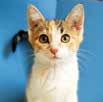
Based on the exciting discovery in animals, the Therapeutics for Rare and Neglected Diseases program in NIH’s National Center for Advancing Translational Sciences facilitated collaboration to advance research on cyclodextrin. Dr. Vite teamed with researchers from NIH, Washington University in St. Louis, Janssen Resarch and Development of Johnson & Johnson, and others to fine tune the therapy.
Penn Vet researchers discovered an effective route of drug delivery for NPC, allowing cyclodextrin to reach the nervous system through the spinal fluid. The NIH clinical trial, headed by Dr. Porter, is now using this method to deliver cyclodextrins to children with this disease.
“It doesn’t get any better than finding something that treats animals and then will go on to treat kids,” Dr. Vite said.
The formation of a scientific collaboration involving academic, industry, government, and nonprofit patient advocacy organizations allowed the successful translation of HPBCD from the laboratory setting to a Phase I clinical trial in a rare disease in a relatively short period of time. If safety is demonstrated, the Phase II trial will follow.
“I feel very thankful to be a part of this collaborative effort,” says Dr. Vite.
For a list of research supporters, visit www.vet.upenn.edu.
WWW.VET.UPENN.EDU/BELLWETHER 21 RESEARCH BRIEFS
Mutations in either the NPC1 or NPC2 gene result in NPC with NPC1 mutations accounting for 95% of the cases and responsible for the disease in cats. Kwon et al (2009) Cell 137: 1213-1224
On April 18, Penn Vet celebrated the successful completion of its Making History Campaign. Dean Joan Hendricks expressed deep gratitude to the donors in attendance. Through the historic generosity of over 17,000 friends and alumni, the School’s $125,000,000 goal was exceeded by over $9,000,000. A total of $134,659,421 was raised to advance the School’s mission of teaching, research, and care.
Highlights of the campaign include the creation of state-of-the-art facilities: Ryan Hospital’s Buerger Family Minimally Invasive Surgical Suite and New Bolton Center’s James M. Moran, Jr. Critical Care Center and Ilona English Equine Performance Evaluation Facility.
In addition, $16.2 million was raised for scholarships in support of Penn Vet’s students — some of the best and brightest in the world.
Exceeding the goal by 278%, $41.7 million was raised by Penn Vet faculty and clinicians in the area of research, allowing the School to continue to find new methods of treating devastating diseases and illnesses, impacting the lives of both animals and humans.

During the campaign celebration, we unveiled the School’s inspirational “Penn Vet Leads” video. Speeches by students and faculty reinforced the School’s world-renowned teaching and research, and the program ended with a lively demonstration by search dog, Socks, of the Penn Vet Working Dog Center.
Look for the October issue of Bellwether, which will highlight in more depth the impact of the campaign, including a list of campaign donors.
22 BELLWETHER SUMMER 2013
CAMPAIGN UPDATE celebrate CORE PRIORITY GOAL CAMPAIGN TO DATE % OF GOAL ACHIEVED Overall $125,000,000 $134,659,421 108% Frontiers of Research $15,000,000 $41,715,420 278% Investing in Care and Research $65,000,000 $64,427,156 99% Supporting Students $20,000,000 $16,283,890 81% Leading the Profession $18,000,000 $5,350,172 30% Meeting Current and $7,000,000 $6,882,784 98% Future Needs – Annual Giving Donor count 17,961


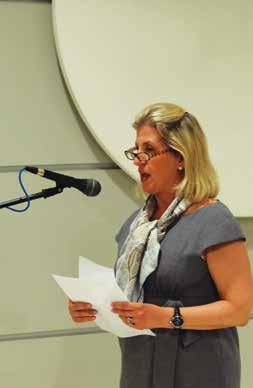



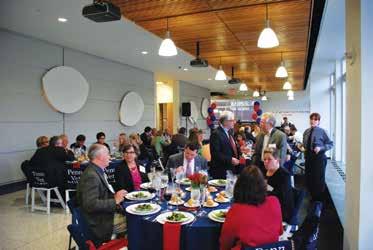

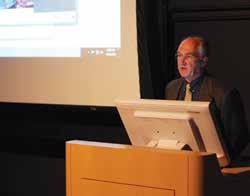


WWW.VET.UPENN.EDU/BELLWETHER 23
GRANTS
Michael Atchison, PhD, received a five-year, $964,640 grant from NIH NIAID T32 for VMD-PhD training in infectious disease-related research.
Dr. Atchison also received a five-year, $524,640 grant from NIH Office of the Director: T35 for short-term training of students in health professional schools, as well as a one-year Merial grant of $20,000.
Igor Brodsky, PhD, received a two-year, $275,000 grant from NIH R21 to study mechanisms of inflammasome inhibition by salmonella.
In addition, Dr. Brodsky received a one-year, $25,000 grant from University Research FDN to study the role of calcium signaling in inflammasome activation.
Peter Felsburg, VMD, PhD, received a one-year, $77,240 grant from Seattle Children’s Hospital to study foamy virus (FV) vector-mediated gene therapy in the canine SCID-X1 model.
Hannah Galantino-Homer, VMD, PhD, received a three-year, $142,147 grant from Grayson Jockey Club Research Foundation to study serum biomarkers for equine laminitis.
Dr. Galantino-Homer also received a two-year, $100,781 grant from the Bernice Barbour Foundation, Inc. for the laminitis discovery database.
Robert Greenberg, PhD, received a two-year, $275,000 grant from NIH R21 to study the role of schistosome ABC transporters in modulation of host immune responses.
Mark Haskins, VMD, MS, PhD, received a five-year, $2.5 million grant from NIH P40 to study animal models of human genetic disease.
James Lok, MS, PhD, received a two-year, $342,517 grant from NIH R21 to study mechanisms and treatment of chronic, latent Human Strongyloidiasis.
Francis Luca, PhD, received a four-year, $1,248,000 grant from NIH for examining the role of cbk1/NDR kinase in regulating mRNA localization.
Nicola Mason, PhD, received a three-year, $281,113 grant from the Morris Animal Foundation to study re-directed T cell therapy in dogs with B cell lymphoma.
Dr. Mason also received a two-year, $96,660 grant from AKC-CHF to study clinical advancement of RNAtransfected CD40-B cell vaccine technology for cancer therapy.
Daniel Morris, DVM, MPH, and Shelley Rankin, PhD, received a 2013 Zoetis Excellence in Dermatology grant in the amount of $32,343.50 to study epidemiological evaluation of Pseudomonas otitis in dogs.
Lisa Murphy, VMD, received a six-month, $9,500 grant from the Commonwealth of PA to study the development of a fast and sensitive LC/MS screening method for the detection of seizure-causing toxicants.
Cynthia Otto, DVM, PhD, received a two-year, $141,345 grant from the Department of Defense to study maintaining hydration of dogs in working environments.
Dr. Otto also received a grant in the amount of $80,000 from Kaleidoscope of Hope Foundation to study the use of detection dogs to identify ovarian cancer.
Thomas Parsons, VMD, PhD, received a one-year, $80,000 grant from SVF Foundation to study on-hoof conservation of endangered swine breeds.
Dr. Parsons also received a two-year, $39,860 grant from the National Pork Board to study how to improve the welfare of group housed sows fed via electronic sow feeding.
Shelley Rankin, PhD, received a six-month, $21,793 grant from the Commonwealth of PA for evaluation of a molecular serotyping assay for Salmonella enterica.
Margaret Sleeper, VMD, received a one-year, $73,387 grant from AKC-CHF for “Therapeutic gene transfer abrogates canine dilated cardiomyopathy.”
Karin Sorenmo, DVM, received a two-year, $97,244 grant from Merial Limited to study the safety & clinical impact of chronic administration of desmopressin in conjunction with chemotherapy in hemangiosarcoma, a spontaneous tumor model.
Charles Vite, DVM, PhD, received a one-year, $86,729 grant from Thomas Jefferson University (Legacy of Angel’s FDN) for intracerebroventricular and intravenous injections of AAVrh10-GALC into the dog model of Krabbe disease.
Daljit Vudathala, PhD, received a six-month, $13,700 grant from the Commonwealth of PA to study the fast and accurate detection of freshwater algal toxins in animal tissues using LC/MS.
24 BELLWETHER SUMMER 2013 CAMPUS UPDATES
FACULTY/STAFF NEWS
Gustavo Aguirre, VMD, PhD, was named to the Institute of Medicine of the National Academies. He also received the International Canine Health Award from the Kennel Club Charitable Trust & Metro Bank at the Cruft’s dog show held in Birmingham, England. He also gave a lecture at the Tongji University Medical School in Shanghai, China.
Gary Althouse, DVM, MS, PhD, was reappointed to a five-year term as Chair, Department of Clinical Studies, New Bolton Center.

The Council of the American Association of Immunologists has awarded David Artis, PhD, the 2013 AAI-BD Biosciences Investigator Award for outstanding, early-career research contributions to the field of immunology.
William Beltran, DVM, PhD, received the Association for Research in Vision and Ophthalmology/Merck
Innovative Ophthalmology Research Award in the Gene Therapy and Eye Disease category in May at the ARVO
Annual Meeting in Seattle, WA. His selection was based on his paper “Gene therapy rescues photoreceptor blindness in dogs and paves the way for treating human X-linked retinitis pigmentosa.”
Darryl Biery, DVM, was awarded Honorary Membership at the 16th International Radiology Association Congress in Bursa, Turkey.
Bernd Driessen, DVM, PhD, was an invited speaker at the World Congress of Veterinary Anesthesia in Cape Town, South Africa in September.

Hannah Galantino-Homer, VMD, PhD, gave a lecture on “Endocrinopathic Laminitis and Equine Metabolic Syndrome” at the California Animal Nutrition Conference in Fresno, CA in May.
Benjamin Wolf, retired professor of microbiology in the Department of Pathobiology, passed away in April 2013 in his beloved Honolulu, Hawaii residence. He is survived by his wife, Sarah, and two sons, Michael and Howard.

Dr. Wolf, earned his master’s degree in bacteriology from the University of Michigan in 1949, and his PhD in microbiology from the University of Pennsylvania in 1959. From 1959 to 1962, Dr. Wolf was a Pennsylvania Plan Scholar and an instructor in the School of Veterinary Medicine. He became an Assistant Professor in 1962, Associate Professor in 1968, and Professor of Microbiology in 1973. From 1962 to 1972, he was the recipient of a Research Career Development Award from the National Institutes of Health. He was involved with the graduate groups in immunology, parasitology, and microbiology and taught core and elective courses on immunology to veterinary students. Dr. Wolf’s graduate students praised his creative mind, hands-on pursuit of scientific endeavors, and unselfish encouragement as he groomed them to become scientists on their own. Anyone who observed how much Ben enjoyed his work would feel inspired to pursue a career in science. It was clear that he relished his interactions with students at all levels and was a source of encouragement.
Dr. Wolf was one of the few immunologists on the veterinary faculty, and his presence was the impetus for what continues to be an active research group within the school. He enjoyed his adventures in experimental immunology and pursued his immunologic research with fervor and tenacity. He is remembered as an encouraging mentor, an interested teacher, and a dedicated scientist.

WWW.VET.UPENN.EDU/BELLWETHER 25 CAMPUS UPDATES
in memoriam
benjamin wolf
ALTHOUSE HANKENSON AGUIRRE
Urs Giger, DVM, PD, MS, was an invited speaker and chaired the Committee on Hereditary Diseases at the World Small Animal Veterinary Association in Auckland, New Zealand in March.

Fuyu Guan, PhD, was promoted to Research Associate Professor, Department of Clinical Studies, New Bolton Center, in December 2012.
Kurt Hankenson, DVM, MS, PhD, was appointed as the first incumbent of the Dean W. Richardson Professorship in Equine Disease Research.
Melanie Hezzell, VetMB, PhD, was awarded an American Kennel Club-Canine Health Foundation Clinician-Scientist Award, which provides research and travel funding. She is studying cardiac biomarkers and mitral valve disease.

Christopher Hunter, PhD, was reappointed to a fiveyear term as Chair, Department of Pathobiology.

Michaela Kristula, DVM, MS, addressed the topic of U.S. dairy heifer export to foreign countries like Turkey by writing an article titled “Heifer exporters should limit disease incidence” for Hoard’s Dairyman: The National Dairy Farm Magazine
John Lewis, VMD, received the AVDS Research and Education Award, sponsored by Hill’s.
Meryl Littman, VMD, did a radio spot on WOND News Talk 1400’s “A Paws For Your Pet” about “Lyme Disease and Other Tick-Borne Diseases in Our Pets.”
James Lok MS, PhD, spoke at the national meeting of the British Society for Parasitology held in Bristol, UK in April.
Kaitlyn Lutz, VMD, was awarded a Western Veterinary Conference 2013 Food Animal Incentive Award. The award is given annually to five veterinarians engaged in a
university or private practice internship or residency (first year) with a focus on food animals.
Nicola Mason, PhD, and Yvonne Paterson, PhD, were named the 2013 recipients of the University of Pennsylvania One Health Award. Mason, assistant professor of pathobiology and clinical studies in Penn’s School of Veterinary Medicine and Paterson, professor of microbiology in the Perelman School of Medicine and associate dean for research and professor of nursing in Penn’s School of Nursing, are collaborating on a project to further develop cancer immunotherapies that are already showing promise in both canine and human patients.
Joseph McGrane celebrated his 50th year at Penn Vet. He was employed by Dr. Jack McGrath at age 17.
Kathy Michel, DVM, MS, has been invited by the American Animal Hospital Association to serve on a task force charged with writing weight management guidelines for dogs and cats.
Adrian Morrison DVM, MS, PhD, has published a book, Brandywine Boy, about growing up on a small farm in the Brandywine Valley in the mid-twentieth century. In addition, the Center for Sleep and Circadian Neurobiology has established an annual Adrian Morrison Lectureship.
Cynthia Otto, DVM, PhD, was chair of the 2013 Penn Vet Working Dog Conference, “The Art & Science of Training: Dog & Handler,” held in April at the Purina Event Center in St. Louis, MO.
With support from Ahold USA, Thomas Parsons, VMD, PhD, participated in an organizational meeting for the Temple Grandin Foundation at the AVMA headquarters in Chicago, IL in May.
Virginia Reef, DVM, recently received the American College of Veterinary Internal Medicine’s Robert W. Kirk Award for Professional Excellence. The award recognizes
26 BELLWETHER SUMMER 2013 CAMPUS UPDATES
MASON
A complete list of faculty and staff news, as well as a list of recent publications submitted by our faculty, will appear in the upcoming online version of Bellwether .
MICHEL HUNTER
REEF REITER
outstanding achievements and dedicated service to the veterinary profession by ACVIM Diplomates.
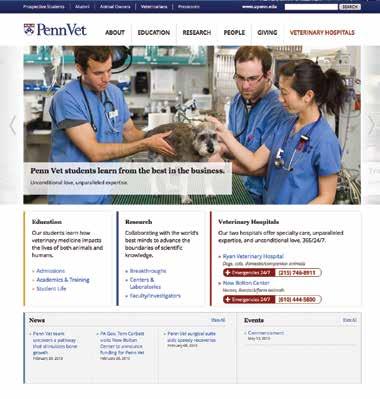
Erica Reineke, VMD, spoke at Western Veterinary Conference in February, as well as the VECCS Spring Clinic in Cancun.

As part of invited faculty of AOVET North America, Alexander Reiter, Dr. med. vet., and John Lewis, VMD, gave several lectures and provided laboratory instruction during a three-day course on the Operative Treatment of Veterinary Craniomaxillofacial Trauma and Reconstruction in Las Vegas, NV.
Alexander Reiter, Dr. med. vet., was appointed to the faculty of AO North America. Dr. Reiter is the organizer of a new course on comparative dentistry and oral surgery at Penn’s School of Dental Medicine.

Carlo Siracusa, DVM, MSc, PhD, participated in the Ceva Animal Health Keep the L.O.V.E. Alive Behavior Express Tour in Baltimore, MD in April.
Matthew Stock, VMD, published in the Journal of the American Veterinary Medical Association with a “What is Your Diagnosis?” case. Also contributing to the case report from Field Service were Billy Smith, DVM, and Jonathan Garber, VMD.
WWW.VET.UPENN.EDU/BELLWETHER 27 CAMPUS UPDATES
Penn Vet Launches New Website Visit often to see how Penn Vet Leads Projected launch: June 2013 Same URL: www.vet.upenn.edu
STUDENT NEWS
Eric Deeble, V’13, received an AVMA Congressional Fellowship to represent the veterinary profession in the legislative branch of government.
Jeffrey Carey, V’14, received the Ed Hiestand Memorial Veterinary Student Scholarship from the National Wildlife Rehabilitators Association. He also presented a lecture in March, “Etiologies of Nodular Skin Lesions in Passerines,” at the NWRA Symposium in Portland, OR.
Marc Meyers, V’15, was awarded first place in the VMD oral presentations at the Phi Zeta Student Research Day in March. He spoke about his project, “Thrombospondin-2 influences revascularization and bone volume in ischemic fracture,” in which he used a mouse model to demonstrate that TSP-2 enhances healing dynamics in ischemic fractures.
Anne Staudenmaier, V’15, was awarded the Morris Animal Foundation Veterinary Student Scholar Program Award for the summer on the topic “Immune response in the common raccoon, Procyon lotor, to modified live canine distemper and feline panleukopenia vaccines.”
leon paul weiss

Leon Paul Weiss, 87, of Merion, PA, former chairman of the department of animal biology at the University of Pennsylvania School of Veterinary Medicine, was a medical doctor who spent his career in research, teaching, and writing, focusing his work on cells and tissues of the immune system and the hematopoietic organs.
I was one of those kids who always wanted to be a vet. Most of you reading this know what I am talking about. Then when I was 18, my dad decided to make a career move from Johns Hopkins Medical School to the faculty of the veterinary and medical schools of the University of Pennsylvania. To me, this move was better than a pot of endless money. It meant that I got to work in the Veterinary School as a college student and that, as a potential ‘faculty brat’, I had a better chance of getting into Vet School.
And then I did get into Vet School. I felt like my dad engineered my career happiness.
I have heard from so many of you in letters and emails about how my dad mentored you and helped in your careers. He never saw roadblocks to inspirations. He supported all of his kid’s dreams, and clearly from many of your emails, he supported others in their career goals.
I think he was a great teacher. Many of you reminded me about what he called the “cilia wiggling in the gut” or of how he described ribosomes as a “beaded necklace.” I saw him create Aquavet so he could work on the Cape in the summers. Marine mammal medicine and even more so, fish medicine, was crazy-talk back then. His thoughts of using animals as caregivers for people were also odd. But he helped make it happen. I remember him after he used colored chalk on the chalkboard, and he would turn around to face the class all purple, yellow, and blue from his chalkboard pictures. I got to see his enthusiasm over the spleen, the lymph, and the red blood cells. He made the pieces of the hematopoietic system into visual characters each with their own story. I feel very lucky to have memories of him as a teacher as well as my dad.
28 BELLWETHER SUMMER 2013 CAMPUS UPDATES
in memoriam
—Alice Weiss, V’84, daughter of Leon Weiss
Bo Connell Named Executive Director of Matthew J. Ryan Veterinary Hospital
On November 14, 2012, Bo Connell assumed the position of Executive Director for the Matthew J. Ryan Veterinary Hospital for companion animals at Penn Vet’s Philadelphia campus.
Since joining Penn Vet, Mr. Connell’s number one priority has been to put the Ryan Hospital on a sustainable path that will ensure a successful future, enabling Penn Vet to fulfill its mission of enriching the lives of those we serve through collaboration, discovery, teaching, and clinical excellence.
By enhancing collaboration among numerous specialties and improving our operations, Mr. Connell hopes to focus our resources more strategically and promote the innovative spirit that has made Penn Vet a world leader.
“Prior to joining Penn Vet’s Ryan Hospital, I recall being impressed by the genuine commitment among the staff to the success of the hospital,” says Connell. “Since joining the team in November, I continue to be impressed by the dedication and collaboration that I see each day. It takes a team to win, and every day I’m reminded that I am on the winning team.”
Throughout the year, clients and colleagues will begin to see some noticeable changes at Ryan Hospital, beginning with new investments in our facilities and technology infrastructure. “These investments are
necessary and will ensure that Ryan Hospital continues to be the veterinary hospital of choice for our clients and our partners in the veterinary community,” adds Connell. “We are particularly excited about the new electronic medical record system that we are developing. This initiative will allow us to consolidate patient information into one system that links to every other system within the hospital, and will greatly enhance our capability as a world-class research institution.”
In addition, Ryan Hospital will focus on developing the specialty care programs where Penn Vet leads the way as an innovator. “Penn Vet Leads is our motto,” says Connell. “And it’s true. Ryan Hospital provides a level of care, clinical expertise, and technology that is not available anywhere else.”
Mr. Connell comes to Penn Vet with years of experience in leadership, finance, planning, and healthcare administration. He previously served as Director of Strategic Initiatives for the Savannah College of Art and Design (SCAD), where he led the planning, development, and start-up of SCAD Hong Kong, the first US degreegranting institution to open in Hong Kong, and assisted with a $380 million operating and capital budget.
Prior to working at SCAD, Mr. Connell served as Director and Administrative Manager for Memorial Health University Medical Center in Savannah, GA, where he developed business and financial plans, managed an ambulatory surgery expansion, increased outpatient surgical volumes by 35 percent, and established a ten-year strategic vision with measurable annual operating plans to meet objectives. Earlier in his career, Mr. Connell held management positions in regional academic medical centers and teaching hospitals, and in the for-profit segment of healthcare.
Mr. Connell has directed due diligence teams to evaluate acquisition opportunities valued at more than $152 million; facilitated hospital-physician joint venture partnerships, resulting in revenue growth of $9 million; and created and managed an inpatient medicine program to reduce hospital operating costs by $1.5 million. In addition to strategic planning experience, he brings extensive knowledge of academic teaching hospitals.
Mr. Connell earned his Master of Business Administration from the University of Florida and a Master of Health Services Administration degree from the University of Central Florida.

WWW.VET.UPENN.EDU/BELLWETHER 29
CAMPUS UPDATES
“Prior to joining Penn Vet’s Ryan Hospital, I recall being impressed by the genuine commitment among the staff to the success of the hospital.”
‘‘
Bo Connell
Penn Annual Conference 113th

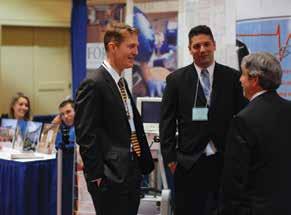
SPOTLIGHT ON SURGERY
March 6 through March 8, 2013
Penn Vet was pleased to present the 113th Penn Annual Conference – one of the largest annual gatherings of veterinary colleagues, alumni, friends and clients in the Philadelphia region. The 2013 Conference focused on surgery and offered the opportunity for attendees to gain knowledge on this very significant component of veterinary medicine. Several other topics were discussed throughout the two-day conference, including dermatology; equine, exotic animal, and food animal medicine; cardiology; endocrinology; orthopedics; and vet tech issues. In addition to the lectures, a third day of educational sessions offered several hands-on wet labs on topics including extracapsular lateral suture repair, intro-oral nerve blocks, cytology, and tooth extraction. Additional conference events included a keynote luncheon with featured speaker Dr. Hansell Stedman of the Perelman School of Medicine, a Dean’s Reception, a Young Alumni Luncheon for graduates from 2003 to 2012, and a Lunch with the Experts forum.
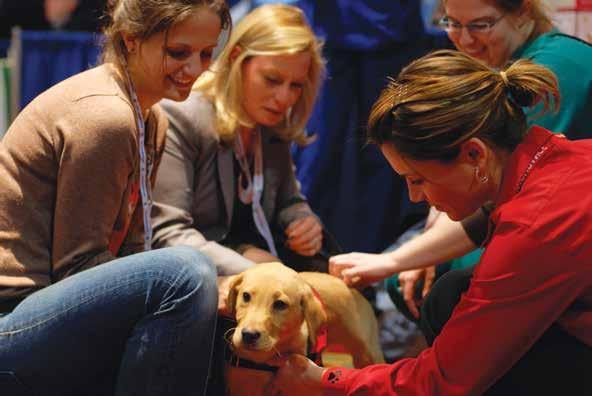
Penn Annual Conference Conference - March 5 & 6

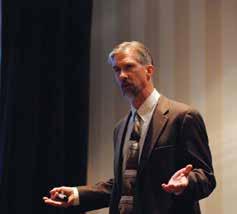


Web Labs – March 7
Sheraton Philadelphia
Downtown Hotel
30 BELLWETHER
SUMMER 2013
SAVE THE DATE
2014
Dean’s Alumni Council Welcomes New Members
DEXTER ARCHER, V’97
Dexter Archer, VMD, the practice owner of Shirley Veterinary Hospital, graduated with honors from the University of Pennsylvania School of Veterinary Medicine in 1997. He spent his first three post-graduate years at a specialty animal hospital. While there, Dr. Archer worked alongside various board-certified specialists in different fields of veterinary medicine, including Surgery, Oncology, and Internal Medicine. He then became the Medical Director for a small animal hospital in Oakdale, NY. After a year in this position, he decided to purchase his first animal hospital, which was located in Riverhead, NY. Dr. Archer successfully practiced there for over six years, building lifelong, compassionate relationships with his clientele. A large portion of these patients followed Dr. Archer when he purchased Shirley Veterinary Hospital in February 2007. Dr. Archer has expanded his role as General Practitioner to include special interests in Internal Medicine and Ophthalmology. His hobbies include fishing, boating, and other outdoor activities. Dr. Archer attends three to four continuing education seminars per year and is dedicated to excellence in veterinary medicine.

GIA CROCE, V’92
Dr. Croce is the anchor of the surgical department at the Delaware County SPCA in Media, PA, and is committed to the collaborative effort for animal welfare. She also is the Lead of the Husbandry Team at Penn Vet’s Working Dog Center. She enjoys training volunteers and veterinary students in performing physical examinations and transferring skills with positive reinforcement to support the pups and acclimate them to veterinary care. Dr. Croce is honored to be a “foster mom” of Kaiserin, the Center’s Dutch Shepherd. She graduated from the University of Pennsylvania School of Veterinary Medicine in 1992 and then completed a one-year small animal internship in medicine and surgery at Cornell University, New York State College of Veterinary Medicine in 1993. The next several years were spent practicing at a progressive, eight doctor hospital in northern New Jersey. Dr. Croce then returned to the Philadelphia suburbs to continue general practice. In 2001, she opened, owned,
and managed Havertown Animal Hospital for over seven years and became involved with SART (Small Animal Rescue Team) task force. Dr. Croce became accredited in Stem Cell therapy in 2008 and provided primary care to several top competitive dogs. The need to balance family and career then allowed her to step down and practice as an associate until electing to pursue a new concentration in shelter medicine. Dr. Croce trained with the Medical Director at the Humane Alliance in Asheville, NC, and became proficient in performing high volume, high quality spays and neuters, gaining invaluable insights into shelter organizations. Her diverse background allowed her to emphasize the health of the population while still ensuring individual animal welfare. Dr. Croce is knowledgeable in American Sign Language and Cued Speech for the hearing impaired, and is involved in a fellowship to help family and friends affected by the disease of alcoholism. Her hobbies include scuba diving, photography, horseback riding, and outdoor exercise, especially with her husband and son (and Kai).

JOHN LEWIS, V’97
Dr. John Lewis is assistant professor of dentistry and oral surgery and residency director at Penn Vet. He is a Diplomate of the American Veterinary Dental College and a Fellow of the Academy of Veterinary Dentistry. Dr. Lewis graduated from the University of Pennsylvania School of Veterinary Medicine in 1997 and spent five years in general practice prior to returning for a residency in dentistry and oral surgery at Penn. Dr. Lewis’ clinical interests include endodontics, feline tooth resorption, feline stomatitis, oral surgical oncology, noninvasive jaw fracture repair, and lasers in oral surgery and dentistry. Dr. Lewis is Immediate Past President of the American Veterinary Dental Society, and he is active on various committees of the AVDS, AVD, and AVDC. He serves as faculty advisor to Alpha Psi Veterinary Fraternity, the student chapter of the American Veterinary Medical Association, and the Shelter Animal Medicine Club. When not treating patients or teaching veterinary dentistry and oral surgery, Dr. Lewis enjoys spending time with his wife, four sons, two dogs, and two cats.
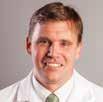
WWW.VET.UPENN.EDU/BELLWETHER 31 DAC UPDATE
ARCHER CROCE LEWIS
The University of Pennsylvania School of Veterinary Medicine is thrilled each year to applaud and recognize outstanding members of our faculty, alumni and professional community. This year was no exception as the Penn Annual Conference award program was filled with talented, dedicated and caring veterinary professionals.
The annual Excellence in Teaching Award was presented to Dr. Rebecka Hess, associate professor of medicine-clinician educator in the Department of Clinical Studies-Philadelphia and chief of the Section of Medicine. Her research interests are in clinical endocrine studies and genetic studies of canine diabetes mellitus.
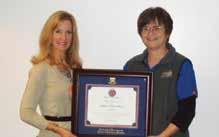
In her nominations, Dr. Hess was lauded as “a wonderful and dynamic lecturer” who “makes sure that her students fully understand the material.” Other comments praised her as being “a pleasure to be around” and “knowledgeable, to the point, thorough and modest.”
The Alumni Award of Merit is presented annually to a select group of alumni who have demonstrated outstanding leadership and service to the School of Veterinary Medicine, excellence in the veterinary profession, and community involvement. Awards in this category were presented to three decades of alumni representing the classes of 1968, 1978, and 1988.
The first Alumni Award of Merit was presented to Dr. Frederick Peterson, who ran a practice in the Green Spring Valley in Maryland prior to moving to South Florida. Dr. Peterson was the second person to sponsor an Opportunity Scholarship, and he then sponsored two additional scholarships. While in South Florida, he hosted several invitational luncheons for the Dean and guests. He headed the performance horse division at Rood & Riddle doing both startup and development. As a result, he became the Veterinary Director for the first World Equestrian Games in Lexington, Kentucky in 2011. As noted from his nomination, “Dr. Peterson has been a constant supporter and is in all ways a credit to our school.”
The second Alumni Award of Merit was presented to Dr. Mattie Hendrick, a member of the Class of 1978.


Dr. Hendrick completed a research fellowship in pathology at Harvard Medical School. She was an assistant professor of pathology at Tufts University School of Veterinary Medicine and a full professor and staff pathologist at Penn Vet. Dr. Hendrick is a Diplomate of the American College of Veterinary Pathologists in anatomic pathology. A Founding Member of the Penn Vet Dean’s Alumni Council, she also served as the keynote speaker for the Penn Annual Conference luncheon in 2011.
Class of 1988 graduate, Dr. Sallie Welte, was the third recipient of the Alumni Award of Merit. In 1996, Dr. Welte was approached about organizing and teaching a course in wildlife medicine so that first-year students at Penn Vet would have an opportunity to learn about this important field. Now in its 16th year, this elective course includes lectures and wet labs and averages about 90 students per semester. The course is very popular and gives students exposure to the field of wildlife medicine that they might not otherwise have. Dr. Welte has also helped facilitate a number of research projects for Penn Vet students and faculty. As Clinic Director at Tri-State Bird Rescue in Newark, Delaware, Dr. Welte has devoted her career to advancing the field of wildlife medicine and providing the best possible care to injured native wild birds. Her service to the community of concerned citizens that bring animals in for treatment is exceptional.
Congratulations to all of our distinguished award recipients!
Alumni Award of Merit nominations are solicited yearround from Penn Vet alumni. To nominate a fellow alum, visit www.vet.upenn.edu.
32 BELLWETHER SUMMER 2013
ALUMNI AWARDS
HENDRICK
PETERSON WELTE
THE RALPH BRINSTER LIFETIME ACHIEVEMENT AWARD
Created in 2011 by the Dean’s Alumni Council, the Ralph Brinster Lifetime Achievement Award is Penn Vet’s highest award of recognition.
As demonstrated by its first recipient, Dr. Ralph Brinster, this award recognizes outstanding individuals who have shown innovation, excellence, and leadership in the veterinary profession both nationally and internationally.

The 2013 recipient of the Ralph Brinster Lifetime Achievement Award is Dr. David Nunamaker, V’68, who received a standing ovation at the award ceremony during the Penn Annual Conference.
Dr. Nunamaker is the retired University of Pennsylvania School of Veterinary Medicine Jacques Jenny Professor of Orthopaedic Surgery. In this role, he tirelessly pursued a greater understanding of the mechanics of bone modeling and remodeling in horses, based on various types of exercise surfaces, and designed a now widely used external fixation device for horses suffering catastrophic leg fractures.
Dr. Nunamaker served as Director of the Richard S. Reynolds Comparative Orthopaedic Research Laboratory, where he conducted in-depth research into many conditions affecting Thoroughbreds and Standardbred racehorses. His work offered the racing industry enlightened alternatives to traditional training methods that would benefit the horse.
He established two patents for external skeletal fixation and researched bucked shins for over 18 years with more than one million dollars in support from the USDA, NIH, and private and industry funding. Through his research, Dr. Nunamaker developed a plan to prevent bucked shins, which could reduce the incidence of this condition from 70-90 percent to less than five percent.

WWW.VET.UPENN.EDU/BELLWETHER 33 ALUMNI AWARDS
NUNAMAKER
NEW ALUMNI PROGRAMS
VMD FINDER
The Alumni Relations Office often receives requests from people relocating to a new city for the names of VMDs. These people are specifically seeking a VMD because of their educational background. The VMD Finder will be an opt-in listing of VMDs by geographic location and we invite you to be part of this new service. Please visit the alumni pages on www.vet.upenn.edu and click on VMD Finder to join this listing service today.
ALUMNI CAREER AMBASSADORS
Remember being a third or fourth year veterinary student? A lot has happened in your career since then.
Think back to veterinary school… days filled with labs and exams and clinics, and all that knowledge to absorb. While you were busy with academics, the question of “What should I do after graduation?” undoubtedly lingered. Perhaps you benefited from the guidance of someone who helped you through these challenges –or perhaps you did it on your own, wishing there was someone with whom you could share ideas.
Current students need advice and direction. That is where you come in. Become an Alumni Career Ambassador today!
As a Career Ambassador, you will be listed as a VMD alum who welcomes current students contacting you with questions about your career path and your perspective on how to achieve success post-graduation. Your responsibility will be to reply to student inquiries in a timely manner and to help them make the most of the Career Ambassador Network.
Why become a Career Advisor?
> An advisor has the opportunity to interact in a very personal and positive way in the career choices of today’s veterinary students and the issues they confront.
> Most of us can remember an individual we respected and admired who provided guidance to us. Many of today’s students do not have such positive role models to help shape their career choices during their formative years.
> You will have the opportunity to interact with some of our best and brightest young veterinary students and develop a relationship with them.
How much of a difference can one individual make?
Your impact can be huge! The positive influence of one individual, as an advisor or role model, is very significant in terms of career choice, direction and success.
How the program works
Students can search the database and select member veterinarians that match their interests. Students will contact you directly.
Advisor prerequisites:
> A love of your profession
> A concern for the future of veterinary medicine
> A desire to make a difference
> An urge to be pro-active
> Motivation to inspire and guide others
The rewards:
> Helping to ensure a bright future for the profession
> Knowing that you are making a positive difference
How do I sign up?
> Visit the alumni pages on www.vet.upenn.edu and click on Alumni Career Ambassador Network for the online enrollment form.
> Email or call Alumni Director Kristen McMullen for a copy of the enrollment form: kmcmul@vet.upenn.edu or (215) 898-1481.
V’77 KEY WEST REUNION
Key West was the perfect location for a reunion of 13 members of the Class of V’77. On Thursday evening, January 24, the Sunset Pier of the Ocean Key Resort and Spa was alive with exclamations of “I haven’t seen you in years!” and “You haven’t changed a bit!” Cocktails and camaraderie were on the menu.
On Saturday morning, a continental breakfast and class meeting were held, where discussions ranged from children, grandchildren, and retirement to what everyone is doing now, what can Penn do for the veterinarian in the trenches, and our Scholarship Fund. The discussions were lively and sincere.
34 BELLWETHER SUMMER 2013 ALUMNI NEWS
Throughout the four-day event, there was plenty of time for visiting with classmates and touring the historical sites in Key West. On Saturday evening, classmates, husbands, wives, and significant others enjoyed dinner at the Conch Republic Seafood Restaurant before heading across the road for ice cream, frozen key lime pie dipped in chocolate, and other sweets. For the last man standing, a shot of tequila at the Hogs Breathe Saloon – a classic in Key West!
ALUMNI AUTHORS & ARTISTS

Arthur Richards, Jr., V’49 is the author of Tale Waggings: Recollections of a Rural Veterinarian, a book that reveals many of the unexpected and humorous cases that kept Dr. Richards hopping for 50 years. A longtime member of the Pennsylvania Veterinary Medical Association, he was its president in 1976 and was recognized as its Veterinarian of the Year in 1977. His hospital was recognized by the American Animal Hospital Association for 38 years. Dr. Richards and his wife have five children and ten grandchildren. He has sold his practice and retired, but continues to do relief work for various local practices.
Howard Lentz Todd Addis, V’59 has authored Our Penn-Marydel Hound: A Historical Anthology with a portion of the proceeds benefiting the MFHA Foundation. For more information, visit www.mfha.org/shop-bookstore. html. Addis has also authored The Addis Carriage Collection and his memoir titled A Backward Glance
Fresh out of the University of Pennsylvania Veterinary School in 1968, Edward Dionne, V’68 was ready to embark on his professional career. He soon realized his education was just beginning. Warm Hearts for Cold Noses chronicles the warm, often hilarious adventures of a young veterinarian learning his trade with a series of unexpected cases and lovable creatures. For more information, visit www.edwarddionne.com.
Lawrence Gerson, V’75 is a regular writer for the Pittsburgh Post-Gazette
Deva Khalsa, V’81 is the author of Dr. Khalsa’s Natural Dog: A Holistic Guide for Healthier Dogs. Dr. Khalsa has become a leading voice on holistic and alternative care for animals.
Lisa H. Handy, V’84 knows there’s no such thing as an “ordinary” day (or night) in her practice. For more than 25 years, Dr. Handy has seen the incredible humor in it all. In the end, she considers it an amazingly rewarding profession, constantly filled with surprises and plenty of horse laughs - all of which are reflected with tongue firmly in cheek throughout her new book, Just for Kicks For more information, visit www.carolinaequineclinic. com/kicks.php.
Brian McGrory’s life changed drastically after the death of his beloved dog, Harry, when he fell in love with Pam Bendock, V’92, Harry’s veterinarian. As he learns how to live by living with animals, Buddy, the family’s pet rooster, becomes Brian’s inspiration in this inherently human story of love, acceptance, and change. For more information, visit www.facebook.com/Buddythebook.
Howard Krum, V’92 along with three classmates, Drs. Roy Yanong, Scott Moore, and Patty Hogan, have written a novel inspired by their experiences as firstyear veterinary students. Dr. Krum noted, “Our primary goals for this book, the first in a series, are to elevate the profile of the veterinary life we love while giving back to worthy programs and causes.” The group is donating a portion of the proceeds from each book sold directly to SCAVMA Chapters at Penn, University of Florida CVM, Colorado State CVM and others. For more information, visit AnAnimalLife.com.
Throughout her life, Catherine “Betsy” Buck, V’00 has sustained two passions – animals and art. She has managed to combine the two, and her skilled sketches were on display at the Vineyard Haven.
Angelee A. Gerovasiliou, V’04 has independently released a new music album titled “MISS YOU.” The album is available online through most music distributors including CDBABY.COM and Apple iTunes. For more information, visit www.angeleemusic.com.
WWW.VET.UPENN.EDU/BELLWETHER 35 ALUMNI NEWS
Pictured: George Bailey, Harold Russell, “Stubbs” Levan, John Hobbes, Dennis McCullough, Steve Bromberg, Dave Samuels, Charlotte Miller Keenan, Cindy Ziegra, Sue McKenzie, and Susan Jacobson. Not pictured-Lynn Giordano Dustin and Ed Donaldson.
PVMA 2013 SLATE OF OFFICERS INCLUDES FOUR PENN VET ALUMNI
Congratulations to the following University of Pennsylvania School of Veterinary Medicine Alumni on their election:
Sherill Davison, V’83, MS’88, MBA’04 elected 2013 PVMA President-Elect. Dr. Davison is Resident Director of the New Bolton Center Pennsylvania Animal Diagnostic Laboratory System, Director of the Laboratory of Avian Medicine and Pathology, and an Associate Professor of Avian Medicine and Pathology
Jim Holt, V’91 elected 2013 PVMA Vice President. Dr. Holt is the veterinarian for New Holland Sales Stables in New Holland, PA, working predominantly with cows and horses. He also works in a mixed equine/ bovine practice doing pre-purchase exams, treating equine lameness, offering second opinions, overseeing imports and exports, and dealing with animal welfare issues as they relate to how animals are treated at sales and equine rescue facilities.
Kenton Rexford, V’94 elected 2013 PVMA President. Dr. Rexford is currently a partner at Pittsburgh Veterinary Specialty and Emergency Center.
Mary Bryant, V’95 elected PVMA Delegate to the American Veterinary Medical Association. Dr. Bryant is the Northeast Regional Director of Field Veterinary Services for Merial. She also serves as Director of Professional Affairs, the liaison between all professional veterinary organizations and Merial.
PENN ALUMNI HONORED BY THE PVMA
Each year during the annual Keystone Veterinary Conference, PVMA honors some of its most outstanding members with awards for their service. At their Hall of Fame Dinner, PVMA honored individuals who were nominated by their peers for their extraordinary contributions. Included in the distinguished honorees that evening were:
Lee Pickett, V’94, who was honored with the Dr. A. Wayne Mountain Memorial Media Award in recognition for her excellence in communicating the importance of veterinary care and pet responsibility through her regular contributions to The Reading Eagle in her weekly newspaper column “Ask the Vet’s Pets.” Dr. Pickett has written the column for ten years in order to educate animal lovers and encourage them to visit their veterinarians regularly.
Heather Berst, V’00, who was named Veterinarian of the Year for her outstanding achievement in veterinary
Mark Your Calendar to Join Us! Penn Veterinary Alumni Receptions
AVMA Alumni Reception
Monday, July 22
Glessner House, Chicago
PVMA Alumni Reception
Friday, August 16
Hershey Lodge
Atlantic Coast Veterinary Conference Alumni Event
Wednesday, October 16
Atlantic City
AAEP Alumni Reception
Monday, December 9
Opryland Resort, Nashville
medicine within the past year. Dr. Berst was recognized for her outstanding work in and dedication to the veterinary profession in many ways, including her work with Hills’ Pet Nutrition as well as her roles within PVMA, Pennsylvania Veterinary Foundation, and the Dean’s Alumni Council at the University of Pennsylvania School of Veterinary Medicine. She was cited as being an enthusiastic volunteer with active leadership in planning of PVF’s annual Bark in the Park 5k Run fundraiser and co-sponsoring dinner meetings and events with PVMA to educate veterinarians on pet nutrition and why PVMA is important.
AAEP HONORS PENN VET ALUMNI
Midge Leitch, V’73, Dipl. ACVS was presented with the AAEP Distinguished Service Award. Dr. Leitch recently retired from the University of Pennsylvania’s New Bolton Center, where she was responsible for the Radiology Service. She joined the AAEP in 1973 and served on task forces, as a board member and as chairwoman of the Equine Welfare Committee from 2008 to 2010.
Wendy Vaala, V’80, Dipl. ACVIM will represent District 5 on the AAEP board of directors. Dr. Vaala has worked as a senior equine technical veterinarian with Merck Animal Health since 2004, after eight years in private practice in New Jersey.
36 BELLWETHER SUMMER 2013 ALUMNI NEWS
SAVE THE DATE
NOTES
The Northeastern Pennsylvania “Old Time Vets” and some not so old vets met at the Wyalusing Hotel for a luncheon and storytelling afternoon. The “old timers” recalled their years of services rendered to small family subsistence. VMDs in attendance included William Corbett, V’79, Amos Hollister, V’53, Bryan Lee, V’60, Skip Nelson, V’68, Walter North, V’63, Carl Reynolds, V’60, Mike Sheruda, V’11,T.W. Shoemaker, V’50, and Megan Tiffany, V’12
John W. Lee, Jr., DVM and his staff of VMDs including Jill Acland, V’09, Steven Berkowitz, V’83, Patricia Blakeslee, V’88, Mark Donaldson, V’93, Ricardo Loinaz, V’08, and Emily Schaefer, V’11 have opened a new state-of-the-art equine clinic and surgical facility in Oxford, PA.
CLASS NOTES 2000s
P. Mark Lopez, V’03 and Elizabeth (Ballard) Lopez, V’03 own and operate Wholesome Dairy Farms in Berks County, PA (www.wholesomedairyfarms.com). It is a grass fed dairy farm producing milk, yogurt, greek yogurt, kefir, and cheeses. The website has a listing of stores in the region that carry their products.
Kevin Wellejus, V’04 moved with his wife, Jill, and two daughters Claire, 16, and Casey, 4, to eastern Wisconsin where he works as a dairy manager for Holsum Dairies. He milks approximately 7,000 cows at two locations.
Meghann (Brumsted) Pierdon, V’05 was named the 2013 recipient of the American Association of Swine Veterinarians Foundation Hogg Scholarship. The scholarship is awarded annually to an AASV member who has been accepted into a qualified graduate program to further his or her education after years as a swine practitioner. Dr. Pierdon is currently pursuing a Postdoctoral Fellowship at the University of Pennsylvania. She plans to use the scholarship to support her pursuit of board certification in the newly formed American College of Animal Welfare.
Erica Tramuta-Drobnis, V’05 started an internal medicine residency at Lehigh Valley Health Network in June of 2012. She currently works at Quakertown
Veterinary Clinic as a General Practitioner and as an Emergency Vet. Dr. Tramuta-Drobnis was deployed for Hurricane Sandy with the Federal National Veterinary Response Team (NVRT-2) and spent time in both New Jersey and New York City. She is a member of the Veterinary Medical Assistance Team through the AVMA.
Fred Baff, V’63 and his son, Wesley Baff, V’06 run Plumtrees Animal Hospital in Danbury, Connecticut. Dr. Wesley Baff was one of 12 people who participated in a 190.2-mile overnight running relay race to raise money for the Jessica Rekos Memorial Fund. Jessica, the daughter of his fellow Newtown High School classmates Rich and Krista Rekos, was one of the 20 Sandy Hook Elementary School students slain on December 14. Last summer, when Jessica’s family vacationed on the Cape, she took an interest in whales. The group is running to raise funds for an internship at the Whale and Dolphin Society’s education outreach program.
Leslie Kuczynski, V’06, DACVIM recently joined the Internal Medicine Department at Metropolitan Veterinary Associates in Norristown, PA (www.metro-vet.com).
MVA is a small animal specialty and emergency hospital that originated in 1986. They currently have 25 specialists in 11 different disciplines.
Nadine Salomon, V’06 serves on the board of the Equitarian Initiative, a group of equine veterinarians and caregivers looking to provide education, leadership and assistance to the working equid and, by extension, their families. Dr. Salomon’s interest in equitarian work started after participating in an RAVS trip on a Nevada Indian reservation during vet school. She is currently an equine practitioner at Allegheny Equine, a private practice outside of Pittsburgh.
Marc Valitutto, V’06 recently appeared on The Today Show for a feature story on the sloth. He is the General Curator, Veterinarian for the Staten Island Zoological Society.
Quack’s Corner, Cumberland County’s only all-volunteer animal rescue and sanctuary, has honored Dr. Ryan Gorman, V’07 with its Golden Egg award. Dr. Gorman is an associate veterinarian and partner at the Millville Animal Clinic. The Golden Egg award is given to those who show extraordinary acts of compassion toward animals. Recently, Quack’s Corner rescued Emmy Lou, a paralyzed beagle found in the woods by a hunter.
WWW.VET.UPENN.EDU/BELLWETHER 37 ALUMNI NEWS
Simeon Taft, V’10 and his wife, Heidi (GrNu’09), welcomed a son, George, on March 22, 2013. The family resides in Fredericksburg, Virginia.
Ashleigh (Walker) Newman, V’10 started her threeyear residency in Clinical Pathology in July 2012 at Cornell University College of Veterinary Medicine.
A fellow in large animal ultrasound and cardiology at New Bolton Center, Laura Faulkner, V’11 has expertise in matters of the equine heart. She presented “What’s the Buzz? Heart Murmurs in Horses” at the Pennsylvania Horse World Expo held in February.
1990s
Ann E. Bastian, V’93 attended the 2012 Paso Fino Horse Association Grand National Championship with her four-year-old Paso Fino colt Rigoleto de Las Camelias, aka Rio. Rio placed in all four of his classes, which is a great showing for his first Nationals.
Christine Kreuder Johnson, V’94 received the UC Davis School of Veterinary Medicine 2012 Distinguished Faculty Teaching Award at a reception on October 2.
1980s
James F. Dougherty, V’80 has joined the Board of Trustees of Rutgers University.
Fern Tablin, V’80, GR’84 received the 2012 Pfizer Distinguished Teacher Award in recognition of her exceptional, sustained, and significant accomplishments in teaching DVM students. This award honors faculty whose ability, dedication, character, and leadership contribute significantly to instruction in the UC Davis School of Veterinary Medicine’s professional curricula.
Stephen Peoples, V’84 has been appointed to a threeyear term on the Orthopaedic Institute of Medicine (OIOM) Council. Steve retired from Johnson & Johnson in 2009 and established Peoples & Associates, a consulting group providing services to the orthopaedic profession and industry.
1970s
David Welch, V’72, MBA, leader of the American Association of Bovine Practitioners Veterinary Practice Sustainability Committee, and Russ Daly, DVM, South Dakota State University, spoke at the National Food
Animal Veterinary Institute meeting on strengthening the rural veterinary infrastructure.
George F. Henning, V’76, MD has been promoted to Full Professor in the Department of Family and Community Medicine at the Penn State College of Medicine and Director of Family Medicine Obstetrics. Dr. Henning recently received the College of Medicine outreach award for his work with the Lion Care free clinic in Harrisburg, PA.
RESIDENT & INTERN ALUMNI
Florien Jenner has taken the reins as the head of equine surgery at Vetmeduni Vienna, the University of Veterinary Medicine in Vienna. She studied veterinary medicine in Munich before working for many years in the United States, and most recently, in Ireland. She completed an internship and a residency at the University of Pennsylvania. In 2006, she accepted a position as lecturer for equine surgery at the University College Dublin’s School of Veterinary Medicine, and obtained her Diploma of the European College of Veterinary Surgeons. Most recently, she completed her PhD on joint development and its implication for tissue engineering of articular cartilage.
IN REMEMBRANCE
Sheldon Farber, V’44 passed away on January 26, 2013.
Peter H. Langer, V’46 passed away at Royal University Hospital. He obtained a PhD in veterinary virology at Cornell University in 1960 and worked for several years in the development of veterinary vaccines before moving to Ottawa, Canada to become the Director of Veterinary Biologics, Canada.
John C. Shook, V’48 of Mechanicsburg passed away at The Fairways in State College, PA. He served in Germany during World War II with the 138th US Army Evacuation Hospital. After completion of his VMD, he opened his own large animal practice in Spring Mills, PA. He then moved into regulatory service, where his life’s work focused on the control and/or eradication of such animal diseases as hog cholera, brucellosis, tuberculosis, and avian influenza. He served as the State Veterinarian of Pennsylvania, and later the State Veterinarian of Maryland. He was a former President and long time Treasurer for the US Animal Health Association.
38 BELLWETHER SUMMER 2013 ALUMNI NEWS
For the most recent alumni updates, visit www.vet.upenn.edu/alumniclassnotes
Calvin Benjamin Umble, V’51 died in Chambersburg Hospital. He and his family moved to Chambersburg, PA in 1967, when he became partner in the Chambersburg Animal Hospital. Prior to joining the Chambersburg practice, Dr. Umble practiced independently in Honey Brook, PA from 1951 to 1964. From 1964 to 1967, he performed research pathology for Rutgers State University in their Vineland, NJ facilities. A veteran of World War II, having served with the 406th Regiment, 102nd Infantry Division, Dr. Umble was awarded the Purple Heart for action in Germany.
Ramsay S. Buchanan, V’54 passed away at his home at Mercer Hill Farm. His work with monkeys for polio vaccine research at Merck Sharpe and Dohme took him on safari to Ethiopia during the ’58 coup d’état and to the Philippines. He became a partner in the King of Prussia Veterinary Hospital with Dr. John Church in 1961, where he practiced small animal medicine until his retirement in 1988. A lifelong horseman and fox hunter, he took great pleasure in working with hounds with Mrs. John B. Hannum, MFH, and was privileged to be an honorary whipper-in for five years, later serving as field master for hound exercising for four summers.
William R. Nehoda, V’54 of Forks Township, PA, passed away in Gracedale. Dr. Nehoda was a retired veterinarian and founder of the Easton Animal Hospital in Forks Township, PA. He served as a captain in the Air Force during the Korean War. Kelly Craig, V’96, who worked for Dr. Nehoda, commented that he was “a man who dedicated his life to his practice, his family and his community.” He served his country, and then practiced mixed animal medicine before founding a small animal practice that is still thriving today under his son’s ownership. His insight and wisdom, honed from decades of practice where history taking, physical exam skills, and instinct were the only diagnostic tools, proved to be a delightful treasure-trove of anecdotes of how things were done “back in the day.” He was like a favorite grandfather and James Herriot rolled into one.
John W. Higgins, V’55 passed away on January 29, 2013. He founded the Yorkville Animal Hospital in 1962
and served as the Director and Chief Surgeon until his death. He loved all creatures great and small.
Edwin Ramsey Gearhart, V’56 died at Sentara Norfolk (VA) General Hospital after a brief illness. After practicing for a year in Hagerstown, MD, he returned to Williamsport and owned Gearhart Veterinary Clinic from 1957 through 1974. He then joined practices in Chicago and suburban Pittsburgh before moving to Virginia Beach, where he owned Independence Veterinary Clinic for almost 20 years before retiring to Florida.
Richard A. Vaclavik, V’56 practiced his craft until just three weeks prior to his passing. Dr. Vaclavik opened the Upper Dauphin Animal Hospital in Millersburg, PA in 1960, where he practiced for the past 53 years. He also served as a veterinarian for the State Department of Agriculture.
Max J. Herman, V’59, 81, of Collegeville, PA passed away at Shannondell in Audubon, PA. In 1963, he founded Trooper Hospital and went on to become board-certified in Animal Dentistry in 1998, establishing Animal Dental Clinic the same year. Dr. Herman graduated from veterinary school and began his career as a Captain in the Air Force in Niagara, NY. In 2005, the Pennsylvania Veterinary Medical Association presented him with the Keystone Award, recognizing his hard work in co-founding the American Museum of Veterinary Medicine.
John E. Tartaglione, V’64, 75, of Blakeslee, PA passed away at Coventry Manor in Pottstown, PA. He was the former owner of East Stroudsburg Veterinary Hospital for 35 years. He had a love for animals, especially horses, and enjoyed spending time in any country setting.
William Stanley Rokus, V’65 passed away at Heritage Hall Healthcare and Rehabilitation Center in Leesburg, Virginia. He was a graduate of Duke University, where he was a member of the football team. Upon graduation from Penn, he opened his practice, Rokus Veterinary Hospital, in Leesburg from 1965 to 2003, devoted to caring for both large and small animals. He served his country during the Korean War in the United States Army.
WWW.VET.UPENN.EDU/BELLWETHER 39 ALUMNI NEWS
Calling all VMDs and former Penn Vet interns and residents! Have you received a promotion, gotten married, had a baby, received an award, had a research finding, or opened a new business? Please share your good news with us! Email the alumni office at kmcmul@vet.upenn.edu or write to us at Alumni Relations, Penn Veterinary
Alumni Office, 3800 Spruce Street, Suite 172E, Philadelphia, PA 19104.
CONTACT US
3800 Spruce Street
Philadelphia, PA 19104-6008
Penn Vet alumni and donors receive Bellwether magazine free of charge.
Penn Vet is proud to print Bellwether magazine on FSC® (Forest Stewardship Council™) certified paper, which supports the growth of responsible forest management worldwide through its international standards.
JUNE 2013
June 15, 2013
Animal Lovers Lecture Series, a free educational lecture series for small animal owners
“COMMONLY ENCOUNTERED DENTAL AND ORAL DISEASES IN CATS AND DOGS”
10:00 AM to 11:30 AM
Vernon and Shirley Hill Pavilion
380 South University Avenue, Philadelphia, PA
Presented by Dr. Alexander M. Reiter, Chief –Dentistry and Oral Surgery Service
June 19, 2013
Wednesday Exchange, a bi-monthly interactive continuing education opportunity for primary care veterinarians
“PERIOPERATIVE PAIN MANAGEMENT: WHAT’S UP WITH METHADONE & WHAT ELSE IS NEW?”
6:00 PM to 8:30 PM
Vernon and Shirley Hill Pavilion
380 South University Avenue, Philadelphia, PA
Presented by Dr. Sandie Perkowski, Head of Anesthesia Service
JULY 2013
July 22, 2013
PENN VET ALUMNI RECEPTION AT AVMA CONVENTION
Glessner House Museum (Coach House), 1800 S. Prairie Avenue, Chicago, IL
AUGUST 2013
August 14, 2013
Wednesday Exchange, a bi-monthly interactive continuing education opportunity for primary care veterinarians
“PANCREATITIS IN DOGS AND CATS”
6:00 PM to 8:30 PM
Vernon and Shirley Hill Pavilion
380 South University Avenue, Philadelphia, PA
Presented by Dr. Julie Callahan-Clark, Internal Medicine
August 16, 2013
PENN VET ALUMNI RECEPTION AT PVMA KEYSTONE CONFERENCE
Hershey Lodge, 325 University Drive, Hershey, PA
SEPTEMBER 2013
September 12, 2013

Penn Vet Surgical Series, a continuing education event with a focus on a variety of surgical topics
For more details and location, please call 215-746-3905
For more information on these events, please contact Darleen Calahan, special events coordinator, at coles@vet.upenn.edu or 215-746-2421.
Nonprofit Organization U.S. Postage PAID Philadelphia, PA Permit No. 2563
calendar











 BY JANE SIMONE
BY JANE SIMONE
































































